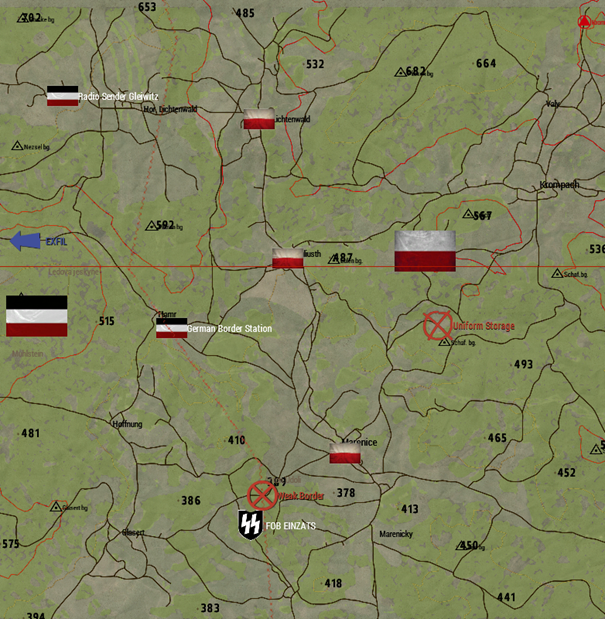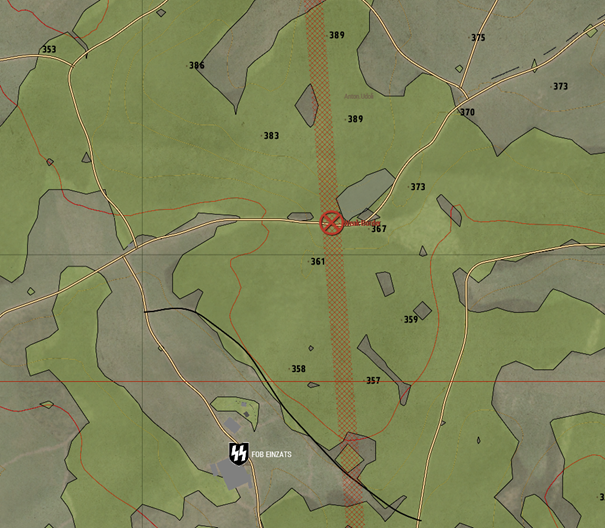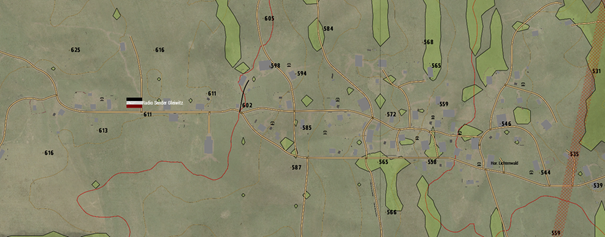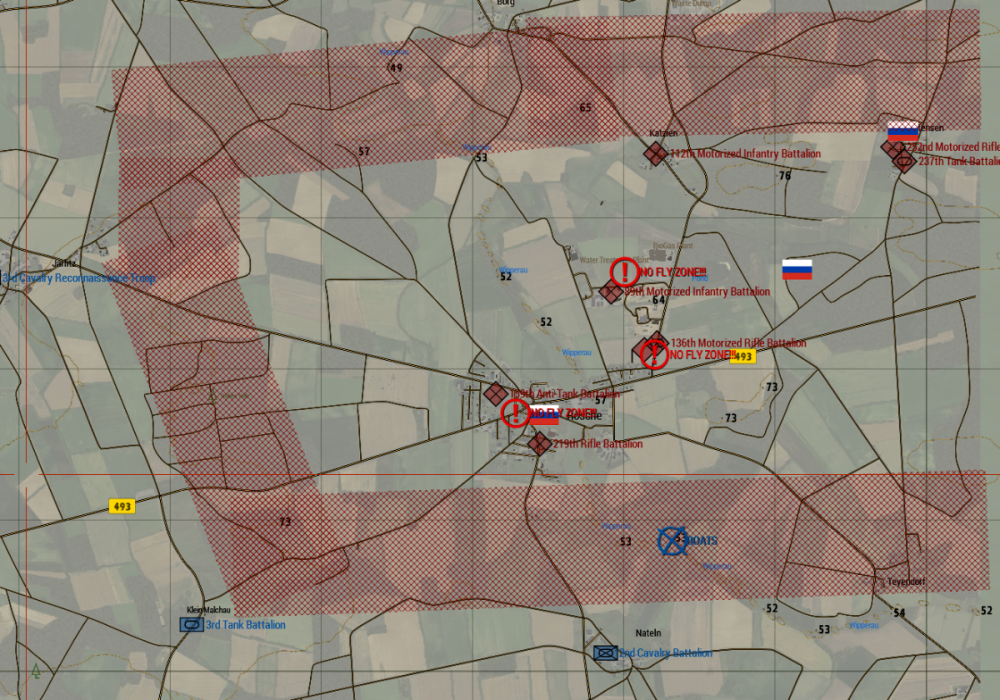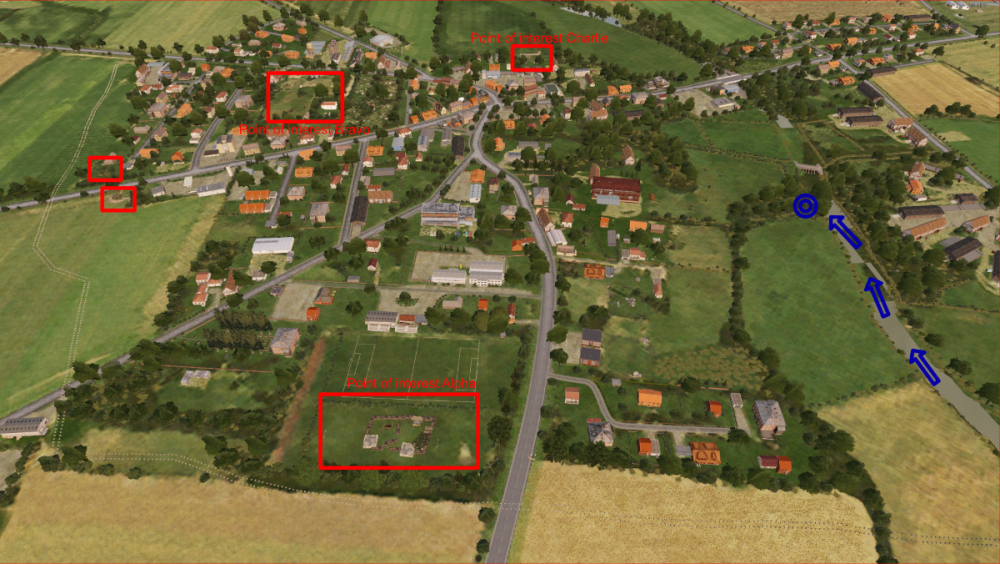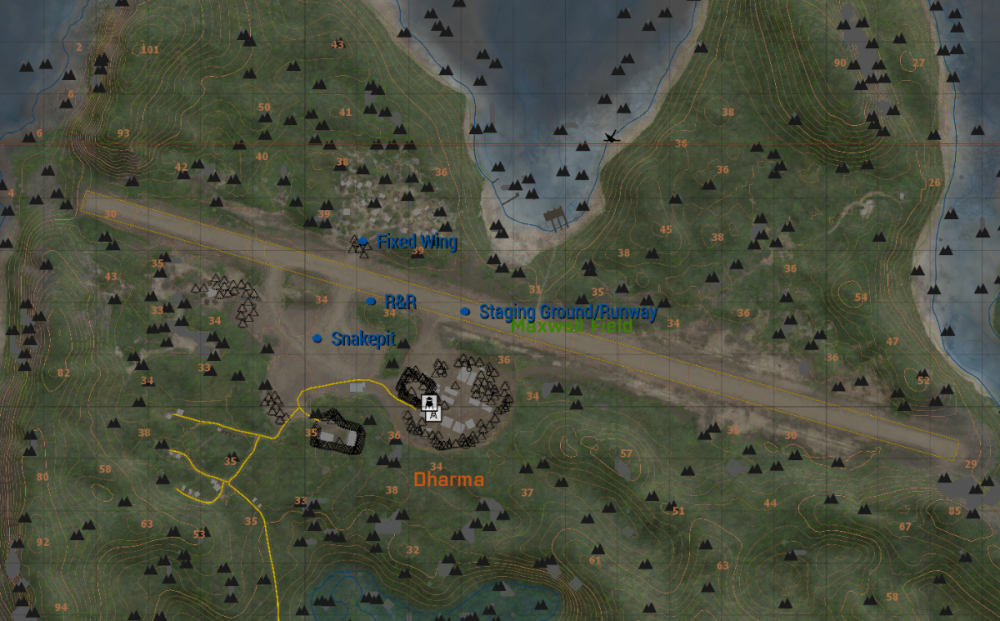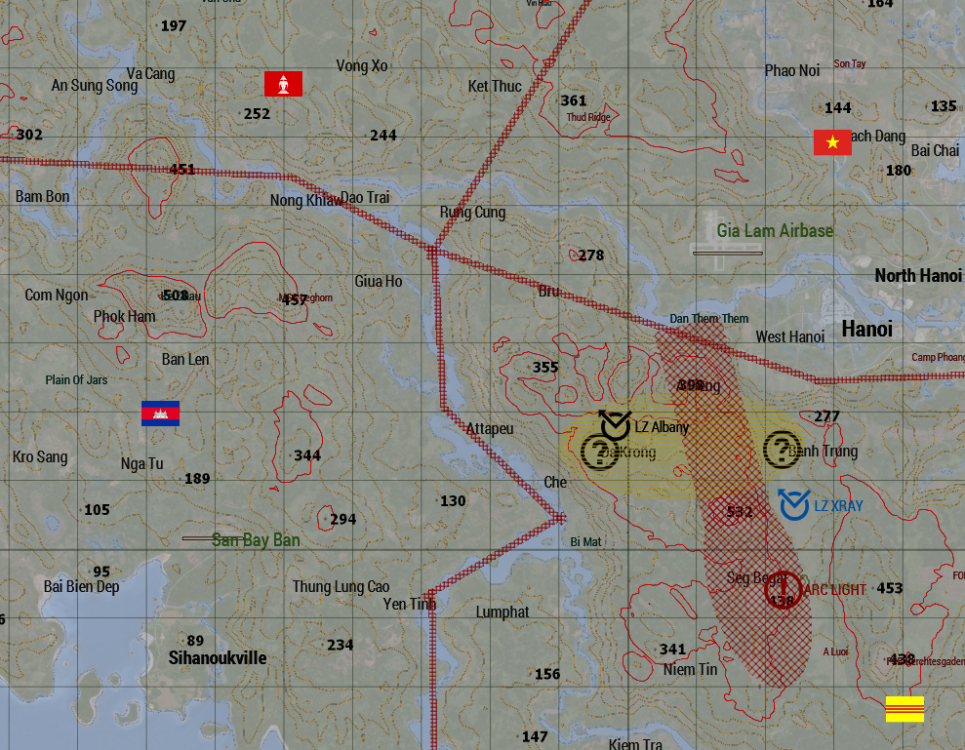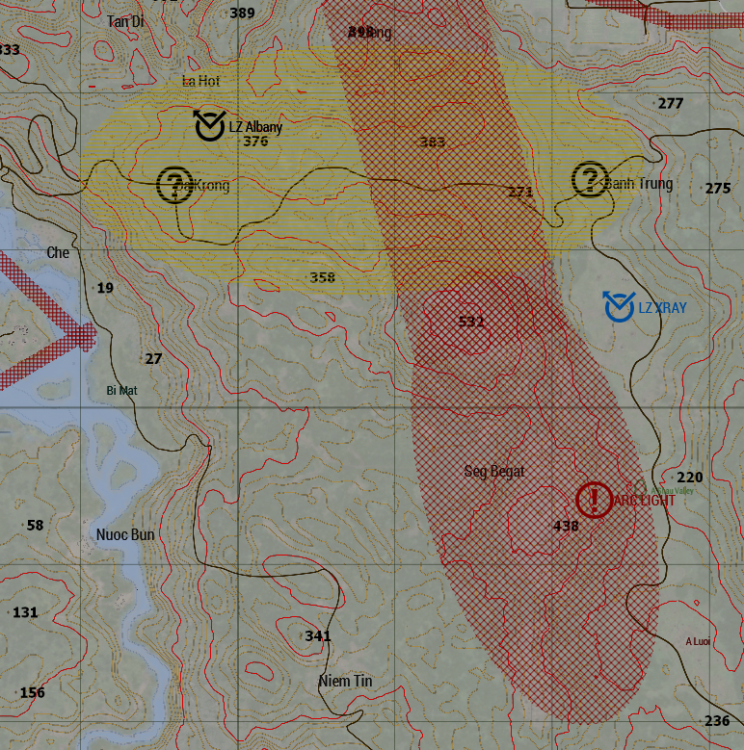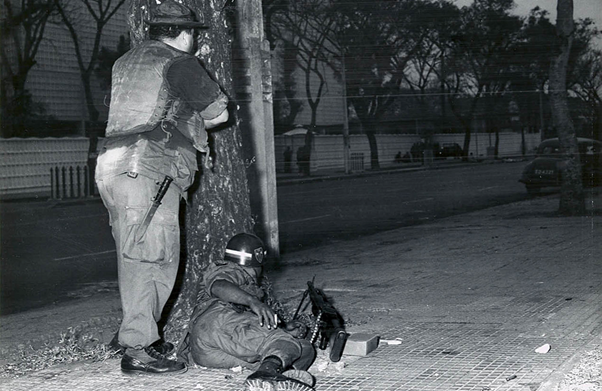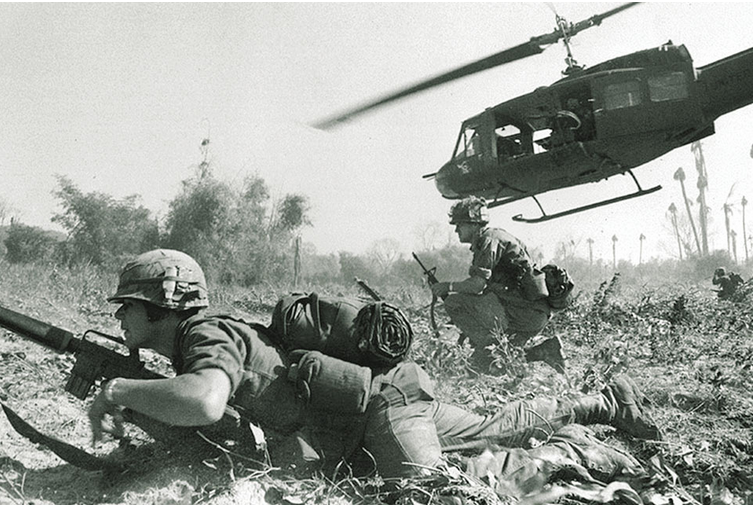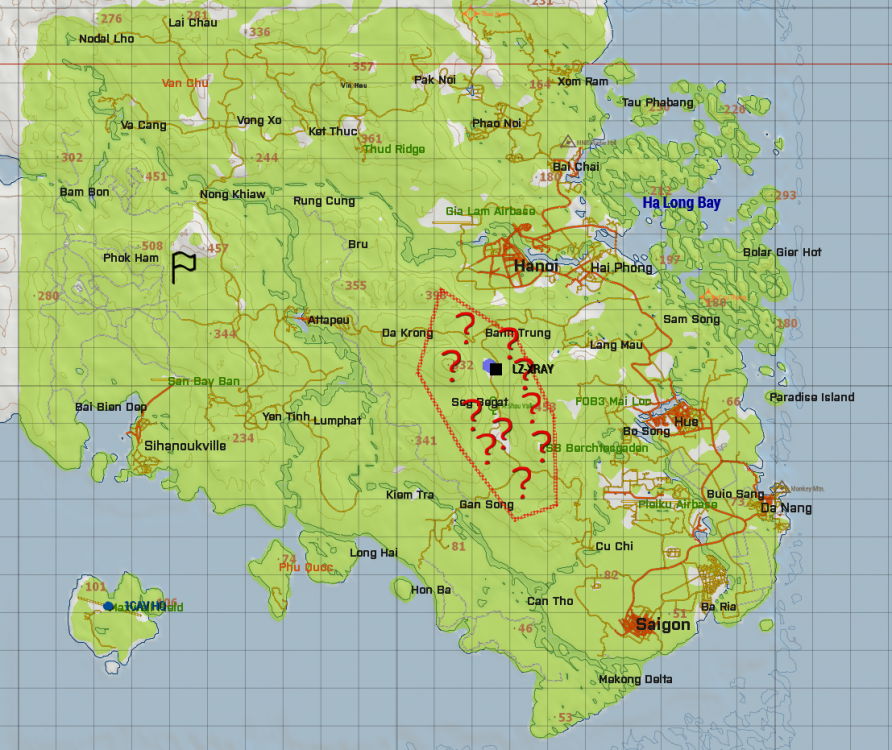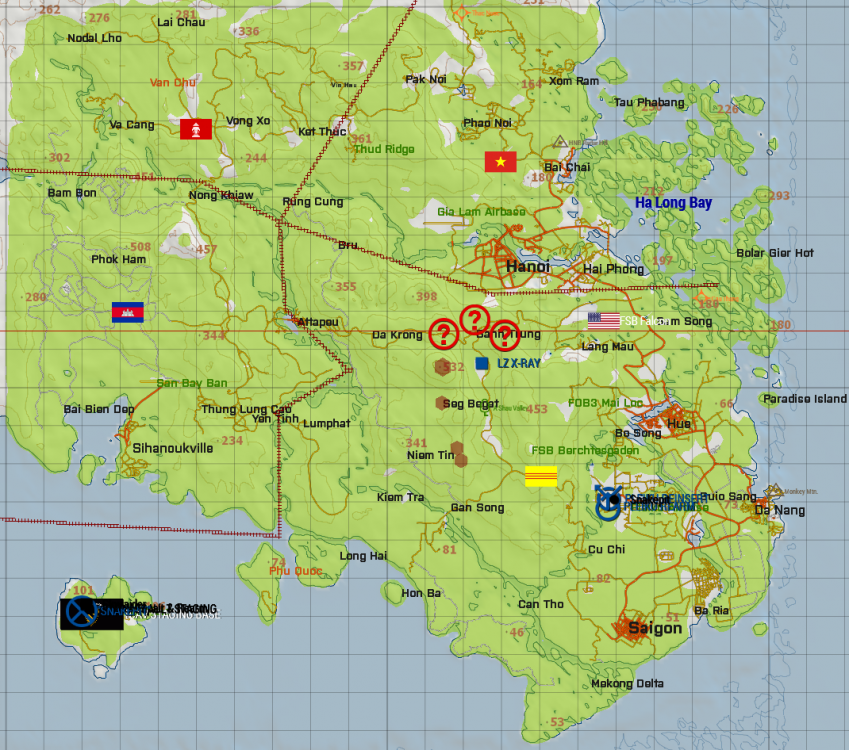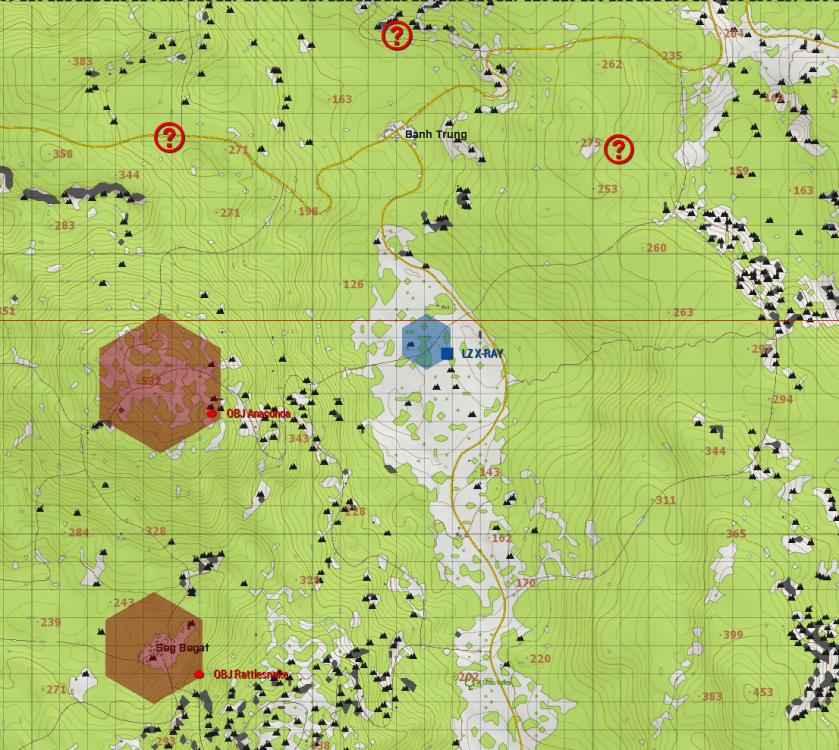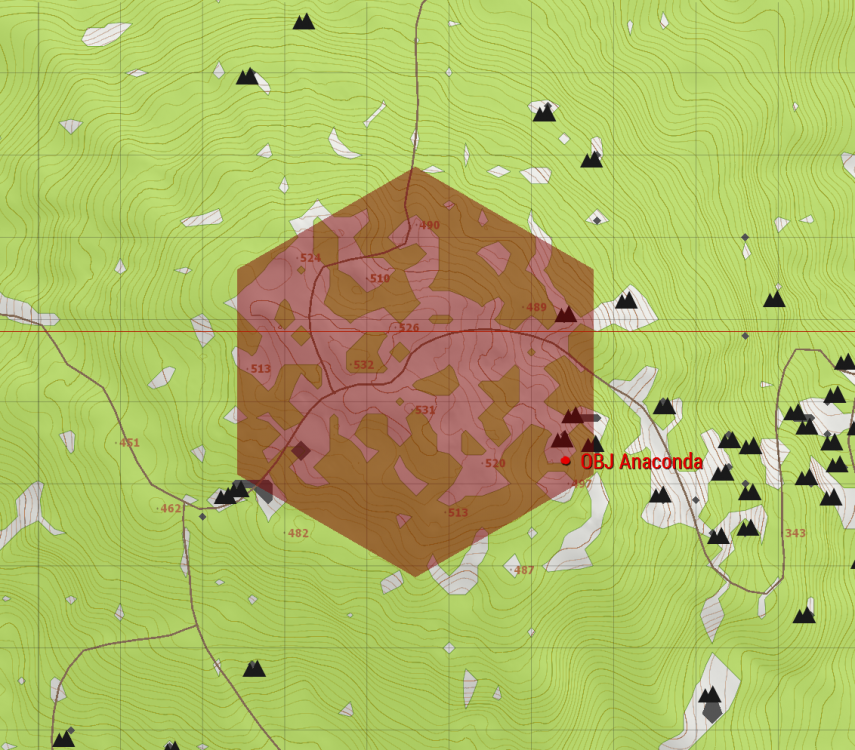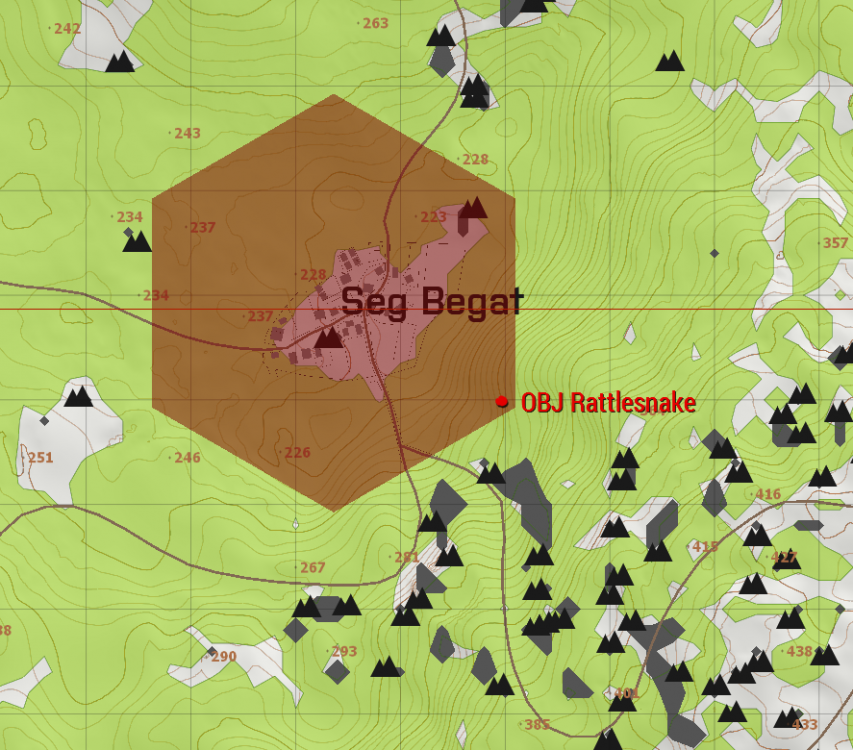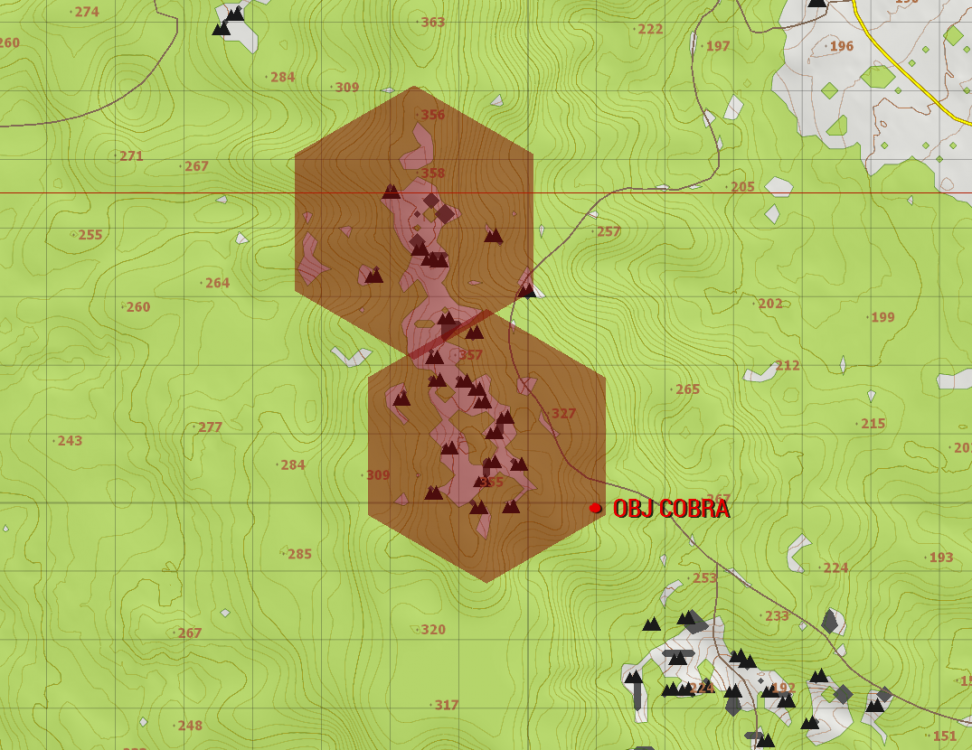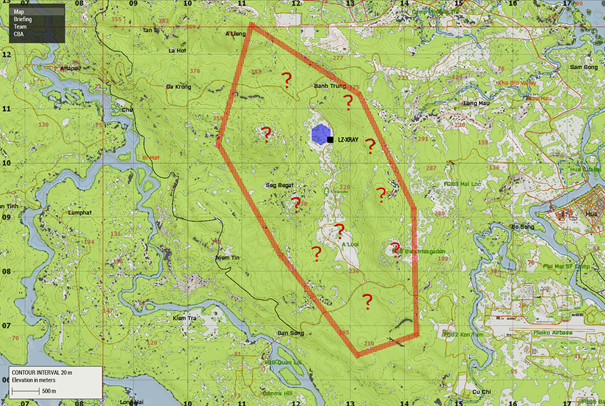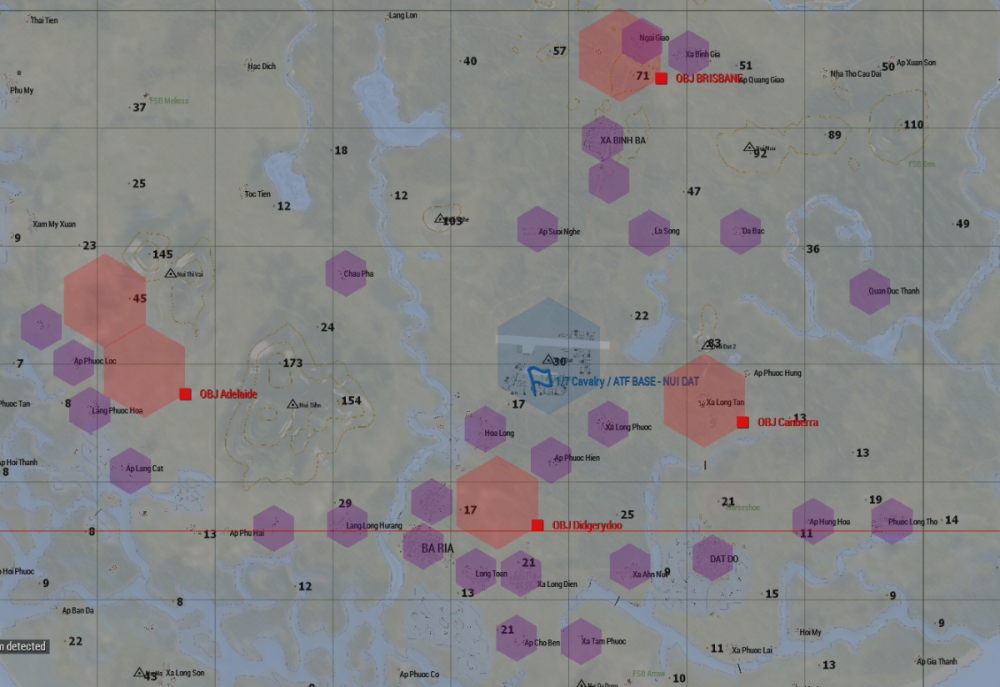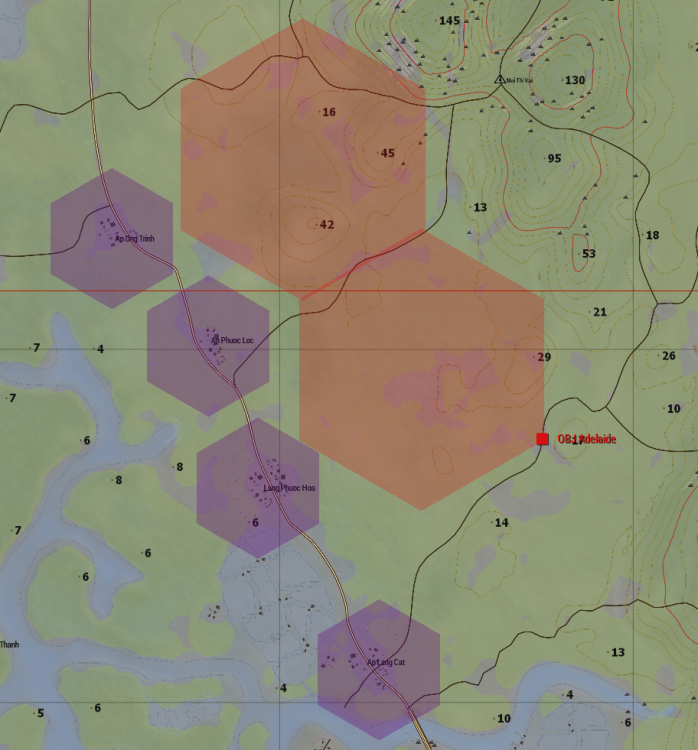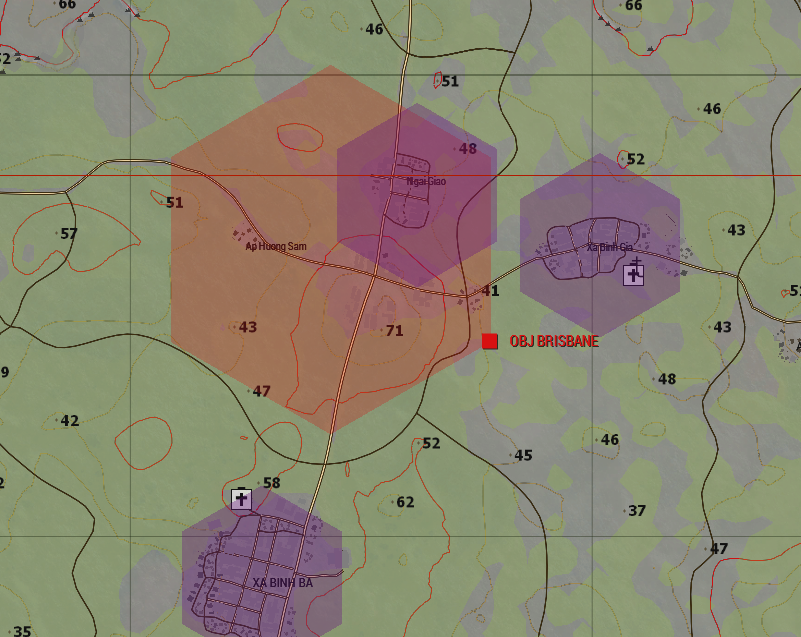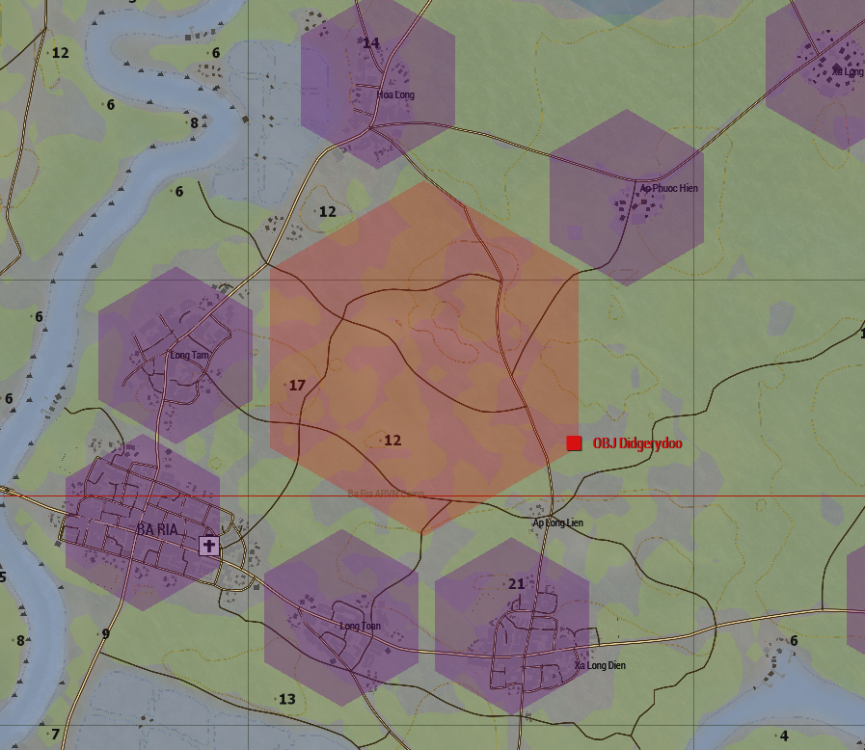

2LT K. Grorud
1st Cavalry Division-
Posts
239 -
Joined
-
Last visited
-
Days Won
2
Content Type
Forums
Events
Downloads
Gallery
Articles
Applications
Everything posted by 2LT K. Grorud
-
WARNING ORDER Polenfeldzug 001 - Operation Konserve Gleiwitz Area, Polish-German Border - 31st August, 1939 One day before the invasion ______________________________________________________________________________________________________________________________________________ SITUATION OPERATION TIME: 1900 EST JAN 15th IN-GAME TIME: 1800 IGT ORGANIZATION: 1. REGION: Gleiwitz area, Polish/German Border 2. WEATHER: Clear Skies; 50F ; Wind <1kn NNE; Dawn 0755 IGT; Dusk 1825 IGT 3. TERRAIN: Farmland, Spruce Forests, Villages Adolf Hitler and Heinrich Himmler have brought forward news of the Poles commencing immense violence of our german brethren living just over the border to Poland. Based on this, Himmler, as well as Reinhardt Heydrich have formed a plan which lets Germany retaliate against the polish atrocities, justified and controlled, the same way we liberated our germanic allies in Czechoslovakia. Historical context (non propaganda): a. Enemy Disposition Polish border forces Polish Border Guards Any Polish QRF German border forces German Border Guards Any German QRF Concentration camp offerings b. Friendly Disposition 8th SS Cavalry Division Florian Geyer support elements c. 1939- Rules of Engagement PID Targets, but make sure you are firing on the right enemy forces. Do not provoke Polish forces/civilians if possible ______________________________________________________________________________________________________________________________________________ Maps of the theatre *How to Zoom in: Open spoiler> Right click on photo > Open image in new tab > Congrats, you can now zoom in. AO: Intelligence: Batallion intelligence has let us know about a polish storage of uniforms, which are crucial to this mission We also have identified the weakest link in the border between Poland and Germany, where you will INFIL German forces will fire upon you once you switch uniforms Notes from Commander: All requests for Close Air Support/Medevac/Resupply/Insertion are to go to Mako 1-6 on FREQ 60.0. Mako 1-6 will contact Rattler 1-6 on FREQ 50.0 to request an asset to assist 1st Platoon as necessary. Once the asset is in the area of Operation for Mako 1-6, Infantry can contact the bird via CAS Net FREQ 45.0 to guide in the bird/direct close air support. ______________________________________________________________________________________________________________________________________________ MISSION 1st Platoon, 1st Battalion, 7th Cavalry Regiment/8th SS Cavalry Division Florian Geyer Sonderkommando 1st Platoons misison is as follows: Inflitrate Poland dressed as civilians, in smaller groups, with arms hidden Attack the polish uniform/equipment storage and switch uniforms Attack the German border crossing Seize the Gleiwitz radio station and broadcast polish anti-german propaganda Leave dead POW's at all attack locations, dressed as polish forces. These will be delivered by truck Exfil Key to this mission is the following: Staying covert during your stay in Poland Do not provoke/attack polish forces, except when explicitly told so Avoid contact with polish military, they will quickly find out that you are not polish! You have no support from German forces once you have switched into polish uniforms/equipment 71st Assault Helicopter Company Rattlers will deploy as infantry for this mission only, during this campaign, due to the missions covert nature and lack of airframes. ______________________________________________________________________________________________________________________________________________ COMMAND & SIGNAL Call Signs Mako 6 2LT K. Grorud Mako 1-6 1LT J. Kauffman Mako 1-6R N/A "Rattler 1-6" N/A "Rattler 1-1", N/A "Rattler 1-2", N/A Hand Signals Control + Num 5 = Rally/Set//Affirmative Control + Num 2 = Halt/Hold/Stop/Negative Control + Num 6 = Engage Control + Num 4 = Go/Move/
-
Time for our next campaign vote! Option #1 WW2 - Commonwealth: WW2 Episodic Europe - Africa 1940-> This will be a campaing where we experience D-Day as Canadians, Commando raids as the Brits (Heavy water etc), and the war in north africa. Expect to do amphibious assaults, gliderborne assaults, and paradropping behind enemy lines to make sure Allied forces win the war. Supported by tanks, sea and air, we will get the true Commonwealth experience! Option #2 WW2 - USA: Pacific Campaign Pacific - 1941-> After the attack on Pearl Harbor, USA launched a pacific campaign to liberate islands captured by the japanese. In this campaign we will experience the true horrors of famous battles like Iwo jima, Guadalcanal and more. Amphibious assaults, starting with springfield in hand, and evolving into inland battles. Experience the jungle with bolt action rifles and banzai charging japanese. Option #3 WW2 - Germany: Invasion of Poland 1939 -> By request of the sole Pole in our unit, the third option will explore the early days of world war 2, and the German blitz into Poland. Tankettes versus brave polish soldiers. Actions behind enemy lines dressed as the opposing force to instigate the war as well. The end of this campaign might also be set in the last days of the war where the soviets push the Germans back.
-
WARNING ORDER Operation Red Inferno 007 Rosche, West Germany - 2021 ______________________________________________________________________________________________________________________________________________ SITUATION OPERATION TIME: 1900 EST IN-GAME TIME: 1800 IGT ORGANIZATION: 1. REGION: Rosche, West Germany 2. WEATHER: Clear Skies; 50F ; Wind <1kn NNE; Dawn 0755 IGT; Dusk 1825 IGT 3. TERRAIN: Farmland, Spruce Forests, Villages After last operations succes in pushing the red menace out of the towns of Neumuhle and Borg, allied commanders feel we have the position to push the red menace back out of Germany. 1st Platoon, 1st Cavalry Division along with attached Rattler elements from the 71st AHC are tasked with sabotaging enemy assets and rescuing POW that are being kept in Rosche. If the opportunity arises to capture VIP's, they will attempt to do so as well. a. Enemy Disposition Soviet and East German Forces Soviet/East German airborne, motorized infantry including BMP's and BTR's. Rotary wing support, Mi-24 / Mi-8 variants Fixed wing CAS, SU-25, MiG variants b. Friendly Disposition 1st Armored Brigade Combat Team, 1st Cavalry Division 1st Cavalry Division Combat Aviation Brigade 1st Airborne Brigade, West German Rapid Forces Division Special Forces Command (KSK), West German Rapid Forces Division c. 2021 - Rules of Engagement PID Targets, engage at will. An evacuation notice has been issued in the region, though some civilians may still be present in surrounding towns and villages. Avoid civilian casualties and damage to infrastructure when possible, though higher authority has declared the AO a free-fire zone on confirmed hostiles. ______________________________________________________________________________________________________________________________________________ Maps of the theatre *How to Zoom in: Open spoiler> Right click on photo > Open image in new tab > Congrats, you can now zoom in. AO: Intelligence: Eastern Bloc forces have occupied and fortified the town itself, facing N-W-S, with east being kept open for reinforcements to trickle in. The enemy has also deployed dragons teeth along the outskirts of town. Bundeswehr recon troops have smuggled in boats for 1st Cavalry Division, so that you may INFIL the city from the river. They also stand by to take out any enemy forces approaching the river as you INFIL. Point of Interest Alpha is believed to be an entrenched Radar site Point of Interest Bravo is believed to be a secondary Radar site Point of Interest Charlie is believed to be the POW camp. Enemy reinforcements are most likely to approach along the main MSR from the east. Notes from Commander: All requests for Close Air Support/Medevac/Resupply/Insertion are to go to Mako 1-6 on FREQ 60.0. Mako 1-6 will contact Rattler 1-6 on FREQ 50.0 to request an asset to assist 1st Platoon as necessary. Once the asset is in the area of Operation for Mako 1-6, Infantry can contact the bird via CAS Net FREQ 45.0 to guide in the bird/direct close air support. ______________________________________________________________________________________________________________________________________________ MISSION 1st Platoon, 1st Battalion, 7th Cavalry Regiment *SOF* 1st Platoon's primary objective is to INFIL Rosche, and take out PoI Alpha and Bravo so that our air assets can reign supreme 1st Platoon's secondary objective is to move to the POW camp and liberate any friendly forces 1st Platoon's third objective is to use any oppourtunity to wreack havoc on the enemy reinforcements, mine approaches, and capture any VIP's. 71st Assault Helicopter Company Rattlers primary objective is to provide CTR (Close target recon) & CAS during 1st Platoon's assault. Rattlers secondary objective is to help intercept enemy reinforcements from the east, to prevent 1st platoon from being overwhelmed Rattlers will also need to be prepared to extract 1st Platoon if needed. DO NOT ENTER THE NO FLY ZONES BEFORE AT LEAST ONE RADAR SITE IS TAKEN DOWN *If desired, Rattler units may opt to augment alongside Mako elements as infantry. ______________________________________________________________________________________________________________________________________________ COMMAND & SIGNAL Call Signs Mako 6 2LT K. Grorud Mako 1-6 1LT J. Kauffman Mako 1-6R N/A "Rattler 1-6" N/A "Rattler 1-1", N/A "Rattler 1-2", N/A Hand Signals Control + Num 5 = Rally/Set//Affirmative Control + Num 2 = Halt/Hold/Stop/Negative Control + Num 6 = Engage Control + Num 4 = Go/Move/
-
WARNING ORDER Operation Long Reach 003: Silver Bayonet I Central Highlands - II Corps - Ia Drang Complex - 1965 ___________________________________________________________________________________________________________________________________________________ SITUATION OPERATION TIME: 1900 EST IN-GAME TIME: 1000 IGT ORGANIZATION: 1. REGION: Ia Drang, South Vietnam 2. WEATHER: Clear Skies; 38F ; Wind <1kn NNE; Dawn 0415 IGT; Dusk 1900 IGT 3. TERRAIN: Mountains, Highlands, Jungle Context Last night, we saw heavy fighting in the hills to the west of LZ X-ray. Due to the high concentration enemy troops, with both the PAVN and VC having established field HQ's in the eare, 1st Cavalry has ordered an Arc Light strike of the mountainrange tomorrow, no sooner than first light. We are to commence a tactical march to our new extraction zone, LZ Albany. HQ has ordered us to strike at any target of oppurtunity along the way, to give PAVN and VC the finishing blow to end this war. The enemy has been here for a while, so be on the lookout for traps/mines. a. Enemy Disposition Unknown disposition of PAVN regulars Well equipped regular soldiers Light - Mechanized Force Anti-Air and Mortar emplacements Unknown disposition of Vietcong Irregulars Ill-Equipped but seasoned Guerrillas Fanatical; Threat of suicide bombers b. Friendly Disposition 1st & 2nd Platoon, Alpha Company, 1st Battalion, 7th Cavalry Regiment 1 Platoon of Airmobile infantry FSB Falcon, as well as fixed wing support c. 1960s - Rules of Engagement On order from your commander, enemy military and paramilitary forces are declared hostile and may be attacked subject to the following instructions: Positive Identification (PID) is required prior to engagement. PID is a reasonable certainty that the proposed target is a legitimate military target. If no PID, contact your next highest commander for decision. Do not engage anyone who has surrendered, or is unarmed or wounded. Any requests for fire support or close air support within 600 Meters of a civilian center must first get authorization from commanding officer. ___________________________________________________________________________________________________________________________________________________ Maps of the Province: AO 71st AHC HQ Notes from Commander: All requests for Close Air Support/Medevac/Resupply/Insertion are to go to Mako 1-6 on FREQ 60.0. Mako 1-6 will contact Rattler 1-6 on FREQ 50.0 to request an asset to assist 1st Platoon as necessary. Once the asset is in the area of Operation for Mako 1-6, Infantry can contact the bird via CAS Net FREQ 45.0 to guide in the bird/direct close air support. If an infantry element is in threat of being overrun and requires immediate assistance, they may declare a "Tactical Emergency" to Mako 1-6, who will then have Rattler 1-6 redirect all available air assets to Mako 1-6's Area of Operation to prevent the unit from being overrun. Expect the enemy to utilize grenades when in close combat. ___________________________________________________________________________________________________________________________________________________ MISSION 1st Platoon, A. Company, 1/7th Cavalry 1st Platoon will perform a tactical march from LZ X-RAY to LZ Albany 1st Platoon PRIMARY TASKING: 1st Platoon will march north to the local civilian strongpoint of Bahn Trung, and will hold here untill the Arc Light subsides SECONDARY TASKING: 1st Platoon will then move west, through the jungle along the trail towards LZ Albany, seizing any opportunity to strike a blow to enemy forces TERTIARY TASKING: Extract from LZ Albany 71st Assault Helicopter Company Rattlers are to support 1st Platoon as they march out of LZ X-Ray PRIMARY TASKING: Support 1st infantry platoon as they move north of Ia Drang, and west towards LZ Albany. Strike any aa-sites that may be uncovered. SECONDARY TASKING: Provide Reinserts, Emergency CAS, Ressuply, and Medevac. TERTIARY TASKING: Extract 1st Platoon from LZ Albany ___________________________________________________________________________________________________________________________________________________ COMMAND & SIGNAL Call Signs "Mako 6", 2LT K. Grorud "Mako 1-6", 1LT J. Kauffman "Mako 1-6R" SSG A. Cummings "Mako 1-1", SSG D. Jordan "Mako 1-2", SSG V. HandbergTBD "Rattler 1-1" CW3 T. Sadler "Rattler 1-2" TBD Hand Signals Control + Num 5 = Rally/Set//Affirmative Control + Num 2 = Halt/Hold/Stop/Negative Control + Num 6 = Engage Control + Num 4 = Go/Move/ Role selection: OPORD:
-
Team(S) Reporting: 1st MP division Map: Cam Lao Nam Tasks: Clear the governors palace and the embassy Secondary Tasks: N/A Date of Patrol: 06/12/2021 Attendees: 2LT K. Grorud SSG A. Cummings SSG V. Handberg SGT B. Snurka CW3 T. Sadler SP6 J. Tank SP5 R. Kris PV2 D. Astrope PV2 R. Standley PVT P. Goodell
-
PATROL EMBASSY SIEGE South Vietnam - Saigon - 1968 ___________________________________________________________________________________________________________________________________________________ OPERATION TIME: 1900 EST ___________________________________________________________________________________________________________________________________________________ 1. SITUATION: HISTORICAL CONTEXT: The US Embassy is under siege! When Gordon D. Rowe, commanding the 716th MP Battalion, has recieved a distress call from the US embassy in Saigon, and is dispatching the 1st Cav MP force to secure the embassy and the surroundings. c. 1960s - Rules of Engagement On order from your commander, enemy military and paramilitary forces are declared hostile and may be attacked subject to the following instructions: Positive Identification (PID) is required prior to engagement. PID is a reasonable certainty that the proposed target is a legitimate military target. If no PID, contact your next highest commander for decision. Do not engage anyone who has surrendered, or is unarmed or wounded. Any requests for fire support or close air support within 600 Meters of a civilian center must first get authorization from commanding officer. 2. MISSION 1st MP Platoon will INFIL Saigon by car/truck, and secure the local govenors home, before securing the embassy itself. There are reports of hostages being held in the compound. We have reports of street fighting, so be prepared for CQB. We might encounter a VC counterattack once the embassy is secured so be prepared to defend civilians and embassy employees.
-
WARNING ORDER Operation Long Reach 002: Silver Bayonet I Central Highlands - II Corps - Ia Drang Complex - 1965 ___________________________________________________________________________________________________________________________________________________ SITUATION OPERATION TIME: 1900 EST IN-GAME TIME: 1000 IGT ORGANIZATION: 1. REGION: Ia Drang, South Vietnam 2. WEATHER: Clear Skies; 38F ; Wind <1kn NNE; Dawn 0415 IGT; Dusk 1900 IGT 3. TERRAIN: Mountains, Highlands, Jungle Historical Context: After Air Assaulting into LZ X-Ray, 1/7 Cav captured an enemy radio operator, detailing the area around LZ X-Ray. Before they knew it, the enemy were upon them. Accurate fire of AK's and SKS's, pushed 1/7 CAV back into the LZ, where they entrenched themselves for the oncoming storm. All the platoons managed to hold fast, and the LZ remained open for the entire day. As starting to evacuate would seal the fates of the last soldiers out, 1/7 Cav and D. Jordan decided to RON and take the fight to the enemy. With knowledge of where the enemy HQ is located 1/7 CAV is ready to repel the first attack before assaulting the PAVN/VC HQ. a. Enemy Disposition Heavy disposition of PAVN regulars Well equipped regular soldiers Light - Mechanized Force Anti-Air and Mortar emplacements Heavy disposition of Vietcong Irregulars Ill-Equipped but seasoned Guerrillas Fanatical; Threat of suicide bombers b. Friendly Disposition 1st & 2nd Platoon, Alpha Company, 1st Battalion, 7th Cavalry Regiment 3 Platoon of Airmobile infantry FSB Falcon, as well as fixed wing support c. 1960s - Rules of Engagement On order from your commander, enemy military and paramilitary forces are declared hostile and may be attacked subject to the following instructions: Positive Identification (PID) is required prior to engagement. PID is a reasonable certainty that the proposed target is a legitimate military target. If no PID, contact your next highest commander for decision. Do not engage anyone who has surrendered, or is unarmed or wounded. Any requests for fire support or close air support within 600 Meters of a civilian center must first get authorization from commanding officer. ___________________________________________________________________________________________________________________________________________________ Maps of the Province: AO 71st AHC HQ Notes from Commander: All requests for Close Air Support/Medevac/Resupply/Insertion are to go to Mako 1-6 on FREQ 60.0. Mako 1-6 will contact Rattler 1-6 on FREQ 50.0 to request an asset to assist 1st Platoon as necessary. Once the asset is in the area of Operation for Mako 1-6, Infantry can contact the bird via CAS Net FREQ 45.0 to guide in the bird/direct close air support. If an infantry element is in threat of being overrun and requires immediate assistance, they may declare a "Tactical Emergency" to Mako 1-6, who will then have Rattler 1-6 redirect all available air assets to Mako 1-6's Area of Operation to prevent the unit from being overrun. Expect the enemy to utilize grenades when in close combat. ___________________________________________________________________________________________________________________________________________________ MISSION 1st Platoon, A. Company, 1/7th Cavalry 1st Platoon will resume where they were left at the RON, and will push the enemy out of the area. 1st Platoon PRIMARY TASKING: 1st Platoon will perform a counter-attack against the PAVN and VC in the vicinity of LZ X-RAY, OBJ Anaconda & Cobra. SECONDARY TASKING: 1st Platoon will sweep the nearby village of SEG BEGAT, OBJ Rattlesnake TERTIARY TASKING: 1st Platoon will secure any documents detailing enemy movements 71st Assault Helicopter Company Rattlers are to support 1st Platoon as they Air Assault and Search & Destroy in the Ia Drang Valley PRIMARY TASKING: Provide Reinserts, Emergency CAS, Ressuply, and Medevac. SECONDARY TASKING: TERTIARY TASKING: ___________________________________________________________________________________________________________________________________________________ COMMAND & SIGNAL Call Signs "Mako 6", 2LT K. Grorud "Mako 1-6", 1LT J. Kauffman "Mako 1-6R" SSG A. Cummings "Mako 1-1", SSG D. Jordan "Mako 1-2", SSG V. HandbergTBD "Rattler 1-1" "Rattler 1-2" WO1 J. Hart Hand Signals Control + Num 5 = Rally/Set//Affirmative Control + Num 2 = Halt/Hold/Stop/Negative Control + Num 6 = Engage Control + Num 4 = Go/Move/ Role selection: OPORD:
-
Team(S) Reporting: 1/7 Boat Crew Map: Cam Lao Nam Tasks: Check boats, supply FSB and extract SOG team Secondary Tasks: N/A Date of Patrol: 05/28/2021 Attendees: 1LT J. Kauffman 2LT K. Grorud SSG V. Handberg SSG D. Jordan SGT N. Bobcat SP5 K. Kersemeier PV2 A. Unit
-
Operation Title: Operation Long Reach 001: Silver Bayonet I Team(S) Reporting: 1/7 CAV Map: Cam Lao Na, Primary Task: Air Assault LZ X-Ray Secondary Task: Survive until RON Time Of Operation: 05/22/2021 Attendees: 2LT K. Grorud CW3 T. Sadler PV2 A. Unit PV2 D. Astrope PV2 R. Standley PV2 R. Witcome PV2 S. Norris PVT H. Flamme SGT B. Snurka SP5 K. Kersemeir SP5 R. Kris SP6 J. Tank SP6 L. Logan SP7 J. Hart SSG A. Cummings SSG D. Jordan SSG V. Handberg
-
WARNING ORDER Operation Long Reach 001: Silver Bayonet I Central Highlands - II Corps - Ia Drang Complex - 1965 ___________________________________________________________________________________________________________________________________________________ SITUATION OPERATION TIME: 1900 EST IN-GAME TIME: 1000 IGT ORGANIZATION: 1. REGION: Ia Drang, South Vietnam 2. WEATHER: Clear Skies; 38F ; Wind <1kn NNE; Dawn 0415 IGT; Dusk 1900 IGT 3. TERRAIN: Mountains, Highlands, Jungle Historical Context: Welcome to Vietnam, Soldier. As your first official operation in Vietnam, you will be doing an Air Assault into the Ia Drang Valley. Col. Hal Moore has selected LZ X-Ray as the base of your assault into the valley. You will show that your "Airmobile" tag is not for display. You are tasked with search and destroy operations in the AO. We expect three VC Regiments in the area, but that should be matched by our mobility and firepower. B52's will perform Arc-light missions before you deploy, so we expect the enemy to be weak. Find the enemy, and inflict as large as possible damage on them, and we will be victorius. General Westmooreland has foolproofed the overall plan to rid the countryside of Vietcong, and we will make sure it happens. Grab the initiative and we will turn this war in our favor. Bodycounts, bodycounts and bodycounts. a. Enemy Disposition Light disposition of PAVN regulars Well equipped regular soldiers Light - Mechanized Force Anti-Air and Mortar emplacements Heavy disposition of Vietcong Irregulars Ill-Equipped but seasoned Guerrillas Fanatical; Threat of suicide bombers b. Friendly Disposition 1st & 2nd Platoon, Alpha Company, 1st Battalion, 7th Cavalry Regiment 1 Platoon of Airmobile infantry FSB Falcon, as well as fixed wing support c. 1960s - Rules of Engagement On order from your commander, enemy military and paramilitary forces are declared hostile and may be attacked subject to the following instructions: Positive Identification (PID) is required prior to engagement. PID is a reasonable certainty that the proposed target is a legitimate military target. If no PID, contact your next highest commander for decision. Do not engage anyone who has surrendered, or is unarmed or wounded. Any requests for fire support or close air support within 600 Meters of a civilian center must first get authorization from commanding officer. ___________________________________________________________________________________________________________________________________________________ Maps of the Province: AO 71st AHC HQ Notes from Commander: All requests for Close Air Support/Medevac/Resupply/Insertion are to go to Mako 1-6 on FREQ 60.0. Mako 1-6 will contact Rattler 1-6 on FREQ 50.0 to request an asset to assist 1st Platoon as necessary. Once the asset is in the area of Operation for Mako 1-6, Infantry can contact the bird via CAS Net FREQ 45.0 to guide in the bird/direct close air support. If an infantry element is in threat of being overrun and requires immediate assistance, they may declare a "Tactical Emergency" to Mako 1-6, who will then have Rattler 1-6 redirect all available air assets to Mako 1-6's Area of Operation to prevent the unit from being overrun. Expect the enemy to utilize grenades when in close combat. ___________________________________________________________________________________________________________________________________________________ MISSION 1st Platoon, A. Company, 1/7th Cavalry 1st Platoon will deploy for an Air Assault into LZ X-RAY, and from there, perform Search & Destroy operations in the AO, to relieve Pleiku. 1st Platoon PRIMARY TASKING: 1st Platoon will Air Assault into LZ X-Ray. SECONDARY TASKING: 1st Platoon will fortify LZ X-Ray, to have a base of operation in the valley TERTIARY TASKING: Search and destroy 71st Assault Helicopter Company Rattlers are to support 1st Platoon as they Air Assault and Search & Destroy in the Ia Drang Valley PRIMARY TASKING: Air Assault into Ia Drang SECONDARY TASKING: Provide Reinserts, Emergency CAS, Ressuply, and Medevac. TERTIARY TASKING: ___________________________________________________________________________________________________________________________________________________ COMMAND & SIGNAL Call Signs "Mako 6", 2LT K. Grorud "Mako 1-6", 1LT J. Kauffman "Mako 1-6R" SSG A. Cummings "Mako 1-1", SSG D. Jordan "Mako 1-2", SSG V. HandbergTBD "Rattler 1-1" CW3 T. Sadler "Rattler 1-2" TBD Hand Signals Control + Num 5 = Rally/Set//Affirmative Control + Num 2 = Halt/Hold/Stop/Negative Control + Num 6 = Engage Control + Num 4 = Go/Move/ Role selection: OPORD:
-
Operation Title: The Battle of Long Tan 001 Team(S) Reporting: Australian Task Force 1 Map: Phuoc Tuy Primary Task: Find and engage enemy artillery positions Secondary Task: Defend Kiwi artillery from enemy advance Time Of Operation: 05/08/2021 Attendees: 2LT K. Grorud SSG A. Cummings SSG D. Jordan SSG V. Handberg SGT B. Snurka SP6 J. Chardi SP6 L. Logan SPC K. Kersemeier SPC R. Kris PV2 H. Flamme PV2 J. Strauss PV2 B. Dman RET E. Saint
-
WARNING ORDER The Battle of Long Tan 001 South Vietnam - 1st Australian Task Force - Phuok Toy Province - 1966 ___________________________________________________________________________________________________________________________________________________ SITUATION OPERATION TIME: 1900 EST IN-GAME TIME: 1200 IGT ORGANIZATION: 1. REGION: Song Be, South Vietnam 2. WEATHER: Clear Skies; 38F ; Wind <1kn NNE; Dawn 0415 IGT; Dusk 1900 IGT 3. TERRAIN: Mountains, Highlands, Jungle, Rolling plains The 1st Australian Task Force (1 ATF) began arriving in Phước Tuy Province of South Vietnam between April and June 1966. Following the establishment of its base at Nui Dat in Operation Hardihood, standing patrols were established outside the base in the evening and clearing patrols sent out every morning and evening along the 12-kilometre (7.5 mi) perimeter. Daily platoon patrols and ambushes were initially conducted out to Line Alpha (4,000 metres (4,400 yd)), which was the range of the Viet Cong (VC) mortars, but were later extended out to Line Bravo (10,000 metres (11,000 yd)) to counter the threat from artillery. Phuoc Tuy Province, South Vietnam All inhabitants of Long Phước and Long Hải villages within Line Alpha were removed, and resettled nearby. A protective security zone was established and a free-fire zone declared. Although unusual for allied installations in Vietnam, many of which were located near populated areas, the Australians hoped to deny the VC observation of Nui Dat, and afford greater security to patrols entering and exiting the area. While adding to the physical security of the base through disrupting a major VC support area and removing the local population from danger, such measures may have been counter-productive. The resettlement resulted in widespread resentment. The VC continued to observe the base from the Nui Dinh hills. Movement was heard around the perimeter over the first few nights as they attempted to locate the Australian defences under the cover of darkness and heavy rain. Although no clashes occurred and the reconnaissance soon ceased, they were believed to be preparations for an attack. On 10 June reports indicated that a VC regiment was moving towards Nui Dat from the north west and was about 10 kilometres (6.2 mi) away. The same day three 120 mm mortar rounds landed just outside the base. That night Australian artillery fired on suspected movement along Route 2, but no casualties were found the next day. Further warnings of an attack hastened the call-forward of 6th Battalion, Royal Australian Regiment (6 RAR), which arrived from Vũng Tàu 30 kilometres (19 mi) to the south on 14 June. No attack occurred, and the initial reaction to 1 ATF's lodgement proved unexpectedly limited. 1ATF have been taking regular shelling by the VC with mortars and old japanese guns. To be able to operate in the area, we have to take them out sooner rather than later. We know of four locations the VC launch their attacks from, and we need to quickly determine which one they attack us from this time, so we can push out and take it out. a. Enemy Disposition Unknown disposition of Vietcong Irregulars Large in number but not well equipped Static Weapons, Light Mortars and artillery guns Complete control of the countryside Heavily mined possible US landing zones b. Friendly Disposition 1st Battalion, 7th Cavalry Regiment In contact with various elements of the 275th and 274th Regiment of the 5th VC Battalion Royal New Zealand Artillery "Kiwi Artillery" c. 1960s - Rules of Engagement On order from your commander, enemy military and paramilitary forces are declared hostile and may be attacked subject to the following instructions: Positive Identification (PID) is required prior to engagement. PID is a reasonable certainty that the proposed target is a legitimate military target. If no PID, contact your next highest commander for decision. Do not engage anyone who has surrendered, or is unarmed or wounded. Any requests for fire support or close air support within 600 Meters of a civilian center must first get authorization from commanding officer. ___________________________________________________________________________________________________________________________________________________ Maps of the Province: *How to Zoom in: Open spoiler> Right click on photo > Open image in new tab > Congrats, you can now zoom in. Map of the AO: Notes from Commander: All requests for Close Air Support/Medevac/Resupply/Insertion are to go to Mako 1-6 on FREQ 60.0. Mako 1-6 will contact Rattler 1-6 on FREQ 50.0 to request an asset to assist 1st Platoon as necessary. Once the asset is in the area of Operation for Mako 1-6, Infantry can contact the bird via CAS Net FREQ 45.0 to guide in the bird/direct close air support. If an infantry element is in threat of being overrun and requires immediate assistance, they may declare a "Tactical Emergency" to Mako 1-6, who will then have Rattler 1-6 redirect all available air assets to Mako 1-6's Area of Operation to prevent the unit from being overrun. Expect the enemy to utilize grenades when in close combat. Bring this in your kit ITEM - Zippo if you want to burn the huts When burning a hut make sure to stand back, and let one person burn the hut, as to avoid friendly fire. ___________________________________________________________________________________________________________________________________________________ MISSION 1st Platoon, A. Company, 1/7th Cavalry 1st Platoon will stand by as a QRF to move out and seize/destroy the enemy artillery to secure safe operations in the area 1st Platoon PRIMARY TASKING: 1st Platoon will stand by at base untill we can locate which of the four objectives go live this coming evening SECONDARY TASKING: N/A TERTIARY TASKING: N/A 71st Assault Helicopter Company 71st AHC is to support 1st Platoon and be on standby for emergency CAS or to pick up prisoners/suspects. PRIMARY TASKING: Rattlers will transport 1st Platoon. SECONDARY TASKING: Provide Emergency CAS, Resupply, and medevac. TERTIARY TASKING: N/A ___________________________________________________________________________________________________________________________________________________ COMMAND & SIGNAL Call Signs "Mako 6", 2LT K. Grorud "Mako 1-6", 1LT J. Kauffman "Mako 1-6 R" TBD "Mako 1-1", SSG D. Jordan "Mako 1-2", SSG V. Handberg "Rattler 1-6", N/A "Rattler 1-1", CW3 T. Sadler "Rattler 1-2", N/A Hand Signals Control + Num 5 = Rally/Set//Affirmative Control + Num 2 = Halt/Hold/Stop/Negative Control + Num 6 = Engage Control + Num 4 = Go/Move/ ROLE REQUEST FORM:
-
In light of the announcement of the SOG Prairy Fire CDLC for Arma, I felt like sharing a story from Vietnam, from a Pilot called Tom Johnson, who served with the A/229th , the "Bandits" . They were attached to 1st Cavalry Division. Bruce "Snakeshit" Crandall (Featured in "We were Soldiers") also flew with the A/229th. Anyhow, this text is an excerpt of Tom Johnsons book, "To the limit - An Air Cav Huey Pilot in Vietnam" He is sent into Laos to pick up a LRRP-team, and even though these arent the Green Berets that will be in the CDLC, it is a reminder on how dangerous the missions were, and how thin of a line they were walking! March 10, 1968 On March 9, the CQ awakens me at 0500 hours and instructs me to meet Major Beyer in the operations bunker. Beyer is grinning and chewing on his unlit cigar. “Tom, how would you like to have a few days off?” I know that smile very well. “No thanks, sir. My last few days off I ended up attached to the Marines in Phu Bai, doing rescue missions inside the Citadel. I don’t want any more of that stuff.” Peter Kretzchmar keeps his back to me and pretends to write assignments on the board. “Sir, if I may ask, did Kretzchmar have anything to do with this assignment?” Irritated by my question, Peter pivots on his heels and frowns. Beyer knows that he and I have little use for each other. “Tom, I thought you might want this one. It’s volunteer only, but fact is, no one in battalion knows for sure what you’ll be doing. If you don’t want it, I’ll give it to somebody else.” “What’s the gig?” “You will report to a Special Forces Group at Hue Phu Bai.” “Uh-huh. Hue Phu Bai again, sir!” Beyer cannot help laughing out loud. “As I was saying, you will report to Hue Phu Bai airstrip at ten hundred hours this morning. Contact Checkmate 29 on 53.46 for further instructions.” “Major Beyer, are you sure you don’t have any idea what these people expect me to do?” “None whatsoever. This is a Black Horse assignment right from Division. You’ll be attached to this group for at least five days, so you’ll need to pack up your clean clothes.” “The other mission was an ‘easy’ one too, sir.” I reply sarcastically. “I get real queasy about missions that are handed down to us from Black Horse. Seems every one of them begins with soft words and ends with double exclamation points.” “I agree with you. My job is to send my most experienced pilots. You, Lee, Martin, and Gore are it. Do you want me to give it to one of them?” I delay my answer by sipping on the hot coffee and watching both Beyer’s and Peter’s eyes, searching for something there that will give them away. Major Beyer has never deliberately misled me before, and I am convinced that he knows nothing about the mission. After a moment, I realize that Peter is also in the dark. “OK, I’ll run it. I’d hate to miss it and then have somebody else tell me it turned out to be a walk in the park.” Kretzchmar assigns WO1 Bruce Farris as peter pilot and Harold Kaney as gunner. By the luck of the draw, the three of us will fly Steven Brown’s Huey. Bruce Farris is not a newbie; he has about 500 hours of combat flying. He graduated in Rotary Wing Class 67-12 and ended up in the Cav immediately after we moved north. Specialist Fourth Class Steven Brown, having great knowledge of how to care for Hueys, was field promoted from gunner to crew chief when Merritt Hawkins DEROS’d two months ago. He also has several hundred hours of Vietnam flying under his belt. I know very little about Harold Kaney. He transferred into A/229th from a grunt unit only a month ago. I stuff all my clean jungle fatigues and other personal items into a rubber laundry bag and walk to the flight line to meet the others. We know that at least the flight will be nice, because it is a beautiful day. There is not a cloud in the sky as we pass the PK-17 checkpoint and skirt the western edge of the city of Hue. Bruce is flying, which gives me a chance to survey the terrain surrounding Hue that was, only days before, the site of major battles. Off to my right, I can now clearly see the area where I executed the emergency resupply for Striker. The LZ was camouflaged in low clouds and rain. Now, although the visibility is unlimited, I am unable to figure out the exact whereabouts of the LZ, and once again, I experience the fear I felt then. After about an hour of flying south, I spot the Hue Phu Bai airstrip. I change the FM radio frequency and make contact with Checkmate 29. We are instructed to land on the eastern side of the runway parking area. Four Hueys are there already. Shortly after landing and before the main rotor blades have slowed to a stop, Checkmate 29, an Army Special Forces captain, arrives in his jeep, accompanied by a lieutenant and a staff sergeant, all of whom are wearing their soft black berets instead of baseball caps. “Mister Johnson, you and your crew can throw your bags in the jeep. I’ll take you to the billeting area.” Obediently all four of us remove our laundry bags and start for the jeep. On the way, I notice the lieutenant and the sergeant briskly walking to the tail boom of our Huey. The NCO, with the help of the officer, proceeds to climb up on the tail stinger. “Excuse me, Sergeant! What the devil do you think you’re doing?” Instead of a reply I receive a go-to-hell look that prompts me to return my bag to the Huey’s cargo compartment and walk to the rear of the aircraft. On the way I meet the officer on his way to the jeep. “Sergeant, how about jumping your ass off my helicopter!” My voice rises in anger. No one without either permission or wings sewn on his chest is going to climb like some overgrown monkey all over the tail rotor gearbox area of my Huey. “It’s all right, Mister Johnson.” Checkmate 29 says. “No, it’s not all right, sir! This is my aircraft, and I say what’s right or not right as pertains to my aircraft.” I am both cocky and gritty in saying this. “You’re wrong, Mister Johnson. This aircraft and its crew now belong to Checkmate. You work for me.” “What are you going to do with that?” Now I’m addressing the lieutenant, who has just passed me with a pail of paint in one hand and a well-used paintbrush in the other. “We are going to paint over your 1st Cavalry emblem.” “Not meaning any disrespect, sir, but the hell you say. You people are not going to paint anything on this aircraft until my people tell me you can.” I reach out and relieve the lieutenant of his paint can with a single quick jerk that nearly pulls him off his feet. Farris, Brown, and Kaney place their bags in the dirt and prepare for the fight that is about to result from anyone daring to paint anything over our 1st Cavalry emblem. When our pride is at stake, as it is here, rank has no privileges, as far as I am concerned. “Mister Johnson, may I have a few words with you in private.” Checkmate 29 grabs my shirtsleeve and leads me away from the others for a discreet discussion. We are barely out of earshot when he wheels around and meets me face-to-face with only 3 inches separating our noses. If this is to be a dressing down of a warrant officer by a commissioned officer, Checkmate 29 is about to get a big surprise. First and foremost, he doesn’t own me. I am just accompanying this unit and couldn’t care less about military courtesy. I could detach myself from this job just as quickly as I got attached to this job without shedding a tear. I mean, what are they going to do to me? Send me to Vietnam? Ground me? The latter would be just great in my opinion. The captain and I argue the point for a good five minutes before he wises up to the fact that he is not going to touch this A/229th property without permission from my boss, Major Beyer. In the end, I take my seat in the Huey while Checkmate 29 fetches his boss, a “light” colonel, who drives out to the parking area. As he exits the jeep, I notice his fatigue jacket label says Creswell. He is probably in his early forties and looks about 5 feet 9 inches or so, and he walks with a slight limp. “Mister Johnson,” Colonel Creswell says diplomatically, and I rise from the sitting position to shake his outstretched hand without a salute. “Yes, sir.” “Now if need be, I’ll get Eugene on the land line.” “You know Major Beyer, sir?” “Mister Johnson, I’ve known Eugene Beyer since he was a wet-nosed lieutenant back in Benning. What’s got you so riled up?” “Well, you see, sir, after we landed, this fellow commenced to crawl up on the tail stinger without my permission.” I am pointing to the sergeant. “And the lieutenant proceeds to hand him a bucket of black paint like they are going to paint a piss tube. Now, I politely asked the captain over there just what the devil is going on and all he would reply was don’t worry about it. Well, sir, I do worry about it. I signed for this aircraft this morning and, therefore, it belongs to me until Beyer says different.” Creswell’s brashness diminishes a little and he pivots to address Checkmate 29. “Did you not explain anything to these people, Twenty-Nine?” “No, sir. At this time, their top secret clearances have not yet been received.” “Captain, I don’t think there will be anything wrong in taking a different approach in this case. All pilots have at least a secret clearance or they wouldn’t be flying, and most have a top secret clearance. How about it, Mister Johnson? Do you have a top secret?” “Yes, sir, I have it.” “See there, Captain. Now what the devil is your problem?” “Sorry, Colonel. I should have handled this a little differently.” “Mister Johnson, let them do their job here, and I will take full responsibility. Eugene won’t mind, I assure you.” “If you say so, Colonel.” “Look, when you get settled in, come by and see me for a drink. I’ll give you some dirt on Beyer to take back home.” The colonel is grinning so broadly that I calculate he and Major Beyer must have been bar-hopping buddies at some time or other. Creswell returns to his jeep and drives off in a cloud of dust. We pick up our bags and place them and ourselves into Checkmate 29’s jeep. As we depart the area, I look back to see the 1st Cavalry tail boom emblem disappearing under a coat of flat black paint. “Folks, I don’t think I’m going to like this stay worth a flip.” “Mister Johnson, I agree. Why do you suppose we’re using all the ‘cloak and dagger’ talk?” “Chief, I don’t know, but I’m sure our good buddy here knows everything there is to know. Isn’t that right, Captain?” Checkmate 29, who has heard our conversation very clearly, doesn’t acknowledge it and continues to drive toward the heavily fenced compound. I guess he’s still chapped off that I got his chain pulled. As we draw nearer, I can tell that this is not an average Vietnam fortification. Multiple-coiled layers of razor-sharp concertina wire form the perimeter. Every 50 feet or so there are in-ground roofed bunkers sporting M60 barrels as decorations. At the entrance two spit-and-polish MPs stand next to their wooden guard shacks. When we drive past the MPs and into the compound, I see a mininetwork of well-kept streets that connect wooden billets and underground bunkers. The grounds are so clean and neat it looks like an in-country R&R spot. As the captain zigs and zags his way through the maze, I am amazed to see several people walking around in civilian clothes—stateside lightweight leisure suits and white buck sneakers. I cannot help staring as we drive by them. It is the first time I have seen civilian dress since R&R in Hawaii. “Spooks?” I ask out loud. The captain snaps his head in my direction, then forward again. “Spooks? What spooks, sir?” Bruce Farris asks. “CIA.” The crew all take a quick look at the civilians who are now behind us. “Embassy people, Mister Johnson.” These are Checkmate’s first words since we left the parking area. “Embassy, CIA—what’s the difference?” I counter. Checkmate does not reply. He makes a sharp left turn in front of a nicely painted billet and brakes to a stop. “This is your new home for a while. You’ll find everything you need inside.” Checkmate volunteers no more information nor does he move from his seat in the jeep. Farris, Brown, Kaney, and I exit the vehicle, bags in tow. “Johnson, I have a very long memory,” Checkmate 29 warns me and then wastes no time in leaving us standing on the roadside. “I think he’s got a real attitude problem,” Bruce cackles. “Yeah, he’s going to be a sore spot as long as we’re here,” I mutter as I turn to walk up the decorous walkway that leads to the door. I have not seen anything like this since leaving Rucker. Rocks painted white outline the walkway. Real grass has been cultivated and is closely cropped all over the immediate area. Inside we find eight cubicles with upright metal clothes lockers and cots whose mattresses have been rolled to the headboard, military-style. This is reminiscent of the preflight barracks at Fort Wolters. At the rear is a sink and a flushing commode. This is definitely not 1st Cavalry quarters, and I begin to feel a little better about having volunteered. In less than 30 minutes, we have our beds rolled out and our gear stowed. I sit on the steps outside the doorway and enjoy the cooling breezes that occasionally sweep through. After so many hectic days of flying without a break, the unexpected idleness simply feels wonderful. The four billets on this street face the rear of another four one block over. All of them seem to be empty except the one we occupy. Several blocks in either direction, I can see other Army and civilian personnel walking up and down the roads as though they are going to a PX somewhere. They seem relaxed and even laugh aloud occasionally, possibly at one another’s jokes. Another hour passes before we have contact with another person in the compound. A jeep pulls up containing a specialist seventh class. It is a rarity to see this rank. “Good afternoon, Mister Johnson,” he says as he exits the vehicle. As he draws nearer, he salutes, and instinctively I duck, expecting a sniper’s bullet to crease my skull. I halfheartedly return his salute. “You guys hungry?” “You bet!” comes Steven Brown’s loud reply before I can open my mouth. “Climb aboard. I’m to give you a tour of the compound and show you where the mess hall is.” We board the jeep, and he departs with a jerk that nearly throws Harold Kaney over the spare tire. As we drive and he talks, I realize that the compound is much smaller than I had first thought. Three lightly guarded underground bunkers catch my attention. Only their entrances are aboveground. What’s in there?” I am scrutinizing the last bunker we passed. “Operations and Planning, sir.” “Just what do they plan around here?” “Mister Johnson, I’ve never been inside one of those bunkers, so I really couldn’t tell you what goes on there. It’s the head shed for these folks. I’ve been told they report directly to MACV in Saigon.” “What kind of people go in and out of these holes in the ground?” I continue to probe. “Last month General Westmoreland himself spent two days here. He had an entourage of more brass and security people than I have ever seen before.” “Westmoreland? Well, I’ll be. Wish I could have been here to tell him what a screwed-up war he’s running.” Eventually our tour guide drops us off at the mess hall. Unlike anything in the 1st Cavalry, it has real stainless steel cookware and a tile floor. Much to my displeasure, there are many Vietnamese civilians working as cooks and waiters. I do not trust these people even a fraction of an inch, and we all manage to keep one eye on them for the entire time we are eating. With our driver gone, we have to hoof it back to our hooch, but I enjoy the short walk, which helps to settle the late lunch. As we turn to enter the walkway that leads to the entrance of our new home, I see a person moving in the shadows at the rear of the billet. Bruce Farris, walking right beside me, sees him too. “What the—hold it!” I stop dead in my tracks and concentrate my vision on the movement of the person inside the building. As a result of my quick stop, Steve Brown and Harold Kaney, who are walking immediately behind, bump into Bruce Farris and me. The figure inside pauses for a moment, then disappears. “Vietnamese inside,” I say softly as I remove my .38 from its holster. The others do likewise. “Spread Out! Kaney get some help!” Harold Kaney races up the street to look for the military police or anyone toting a weapon. The rest of us take positions on opposite corners of the building, just in case the intruder decides to jump out a window. I continue to hear noises from inside as the perpetrator moves about, but I cannot see what is going on. Having no desire to rush inside on my own, I choose to wait for help to arrive. Time passes slowly and I get more nervous that the individual will attempt to escape before the MPs get there. Suddenly three jeeps at near maximum speed slide around the corner, nearly turning over in the process. As they steady up in our direction, I can see that each is bristling with roll bar–mounted M60 machine guns, and one MP is hanging onto the rear of the gun for dear life. As the jeep slides to a stop in front of the billet, the machine gunners point their barrels directly into the doorway. Farris, Brown, and I take this as our signal to get out of there, pronto. Other heavily armed people promptly flood the area, including the “civilians” with the white shoes, knit suits, and dark sunglasses. The latter are carrying the most exotic small-caliber machine guns I have ever seen. Three more jeeps and fifty more people speed to the area at the rear of the billet and take up firing positions. “What did you see, Johnson?” It is Checkmate 29, who has hustled through the crowd to locate us. “Gook inside,” I reply as I holster my Smith & Wesson pistol. “Gook?” “Yeah. We were returning from chow, and as we neared the doorway, I saw one non-American individual inside going through our things.” “Was it your hooch-maid?” “Hooch-maid? What the hell is a hooch-maid?” Sneering with disgust, the captain departs our conversation and races to a point just in front of the billet. He calls out something in Vietnamese. To my surprise, the individual inside replies in Vietnamese using a normal tone of voice. Checkmate 29 waves his hands in the air and shouts, “HOOCH-MAID, HOOCH-MAID! EVERYBODY, HOLD YOUR FIRE!” After a few more Vietnamese words from the captain, the individual appears in the doorway. It is an old woman carrying a broom. I am the recipient of many looks that seem to say, “What a dumb ass,” from the other individuals called up in this emergency. Then the forces disband. Many are shaking their heads and laughing as they walk and drive away. I have to admit that I am terribly embarrassed at the whole thing, but I still feel that it’s better to be foolishly cautious than carelessly dead. The captain, holding the hand of the old lady like a Boy Scout helping her cross the road, ushers her into the area where we are standing. “This is Vong-Ti-Lakk, your hooch-maid,” the captain says, using perfect Vietnamese dialect in the pronunciation of her name. “She is 81 years old, but she works like a water buffalo. She will keep your billet clean. Vong-Ti-Lakk, meet Mister Johnson.” As the captain looks up at me through his dark Ray-Ban sunglasses, it seems to me he is gloating. The old lady, who is all of 5 feet tall, uses her free hand to raise the brim of her round straw hat, then looks up at the tall American and smiles. I intuitively smile back until I see her teeth. I think all of us jump back a little, fearing plague. Her teeth are as black as coal. “What the hell is the matter with her teeth?” I inquire excitedly. “Teeth?” Confused at first, the captain leans down to look for himself. “Oh that! That’s betel nut juice.” “Betel nut juice?” Brown and Kaney ask in unison. “Yeah, they chew betel nuts. It’s a pastime here like chewing tobacco back home. The juice is a mild narcotic. It makes these old bones of hers hurt less. Only thing is, it turns the teeth black.” Up until now, when I’ve thought of hooch-maids, I’ve thought of young, good-looking Vietnamese women with pearly white teeth, who not only clean one’s living area but also are associated with certain pleasurable activities. Now that I’m meeting my first real hooch-maid, I can’t help laughing out loud. The old woman is tickled at my laughing and smiles again, displaying those “pearly whites.” That sets me off all over again. Soon all of us, including the captain, are beside ourselves. This is perhaps the ugliest woman I have ever seen, and she is our hooch-maid. The captain, who is labeled Griffin on his fatigue shirt, again speaks Vietnamese to the old woman. I guess he tells her to go back to work. She replies, “Okey dokey,” which are probably the only English words she knows, and toddles across the street and into the billet. “OK, 1st Cavalry, I guess you people aren’t used to being around Vietnamese too much,” Captain Griffin says. “Not live ones,” I reply and suddenly realize that he is correct. Due to the nature of our jobs, we are rarely in a position to mingle with the populace except when we get haircuts just outside the perimeter of LZ Sharon. “OK, Johnson, I screwed up and you screwed up. What do you say we call a truce.” “I didn’t screw up, Captain. You did. You people should have done a better job briefing us.” I say this with a smile, and Griffin knows I’m not serious. It doesn’t matter anyway. To the rest of the compound people, all 1st Cavalry people must be a little short of bricks if they can’t tell a hooch-maid from an enemy. “All right, I accept responsibility. Listen, it will be tomorrow before the top secret clearances arrive from MACV for your other three people. How about I show you guys where the beer hall is and we have a few drinks together.” Griffin looks at his watch as he speaks. I guess that since it’s late afternoon, his workday is over. Brown and Kaney nearly knock me over in their eagerness to follow this guy anywhere that will end in a cold beer. I am a little more restrained but feel the same way: A cold beer will surely hit the spot. The afternoon is spent unwinding at the beer hall. I like this place more and more as each hour passes. At about 1900 hours, four other helicopter crews come in. They have been flying all day and look tired and a little ragged. I repeatedly ask about their missions, only to be told, “You’ll find out soon enough.” The only thing I am able to learn is that all four are from different divisions. One group is from the III Corps area, which lies some 300 miles to the south. They are surprised at the fact that we still wear our 1st Cav patches on our jungle fatigues. I notice that their shoulder patches have been removed, leaving only the shadowed outlines of the patches that once were there. This should be telling me something, but right now I am enjoying being half-crocked and choose not to question the newcomers any longer. Darkness has fallen, along with two gallons of Budweiser, when the tired 1st Cavalry helicopter crewmembers stagger back to their billet. We feel splendid, and for the first time in a very long time, we feel that our war in Vietnam is far away. This will change the following morning. March 11, 1968 At 0700 hours, the four of us, with another Huey crew that has arrived during the night, find ourselves in one of the underground bunkers for an indoctrination briefing. Our dog tags and other personal identification are confiscated. We are issued razor knives to cut free all the patches sewn on our uniforms. At 0730 hours, Colonel Creswell enters the room. Without hesitation, he begins uncovering the wall maps labeled “TOP SECRET” in large red letters. I do not like at all the fact that the maps show territory in Laos and have little pin flags stuck deep within this no-man’s-land. On each pin flag is an unusual name such as Quick Death, Mother’s Wacker, and Coffin. The president of the United States has repeatedly denied that we are doing anything in Laos or Cambodia. Though I do not particularly like what I am hearing, I am now part of something clandestine and important. Creswell’s briefing is repeatedly interrupted by the “civilians” handing him notes. Phrases like “interdiction units” and “reconnaissance-in-force” fall frequently from his lips. I soon learn that our job is to insert and extract Special Forces Long Range Reconnaissance Patrols deep inside Laos. “Gentlemen,” Creswell says near the end of his briefing, “as far as the United States is concerned, you simply do not exist. Should you go down in Laos, you will make all attempts to make your way into friendly hands. Should you not be able to accomplish this, you will simply be listed as missing in action somewhere within Quang Tri province, Republic of South Vietnam. You are strictly forbidden to divulge anything about these missions in any fashion to anyone, either here in the compound or when you return to your parent units. If you fail to adhere to this policy, you will find yourselves in a court-martial for treason. “You will be allowed to write one letter home to your loved ones explaining the absence of mail for the next ten days. Your letter must not allude to your whereabouts, and you should also refrain from any “juicy” stuff, because each letter will be censored by military personnel prior to its being mailed. “You will remain on standby for your entire stay here. There will be no imminent warnings of a mission about to happen. Therefore, your location must be known to the other members of your crew should you stray from the immediate billet area. I suggest you keep your helicopter in perfect running order, as there will be no time for preflighting prior to a mission. You will want to do a normal run-up every morning as a precaution.” Placing his slim metal pointer on the speaker’s podium, he changes gears from commander to grandfather. “Gentlemen, now that you know something of what will be required of you, you can still back out. At this point, you can load your butts up in your Hueys and return to your units.” He watches and waits for any response. “Sir, how much trouble have your people had on these missions?” I feel compelled to ask. “Mister Johnson, we have inserted teams and never heard from them again.” His reply is shockingly cold and honest. “How many, sir?” “Three in the last year.” “Did they get out?” “Not yet.” “Did you hear from them after the crash?” “No contact was ever established.” Creswell pauses, then changes the subject. “You people will remain with us for five to ten days. For much of the time there will be no activity. Truth is, many crews go home having never cranked for a single mission. If we require your services for a mission, you will complete the assigned task and most likely be released to return to your parent units. No crews have flown more than two consecutive missions while assigned to us. “We do not run missions at night, so your duty day will end at 1800 hours. You are then free to visit the beer hall. There will also be occasional trips to the main Navy commissary, which is located about a mile or so outside the compound.” Having made his best effort to temper the bitter with the sweet, Creswell goes back to being an Army officer. “Anyone want to leave?” he asks. There is a long pause that indicates all eight of us are here for the duration. “Good. I need to talk to the aircraft commanders. The rest of you return to your billets and write those letters. Captain Griffin will come by later to pick them up. DO NOT seal the envelopes please. You are dismissed.” Everyone leaves except Colonel Creswell, another warrant officer, and me. In this private meeting, we are given the necessary maps and a small SOI of only two pages. “Your helicopters are being outfitted with McGuire rigs. On almost all your extractions and some insertions you will be required to use them. Have you men ever used the McGuire rig before?” We both answer that we have, and he continues the private briefing. Then we are released. After finishing my letter to Pat, I find the rest of the crew inspecting Steven Brown’s Huey more closely than ever before. We will be flying over some very bad country, and if anything is wrong with the aircraft, we want to know about it now. After an hour of looking inside cowlings and pulling on hoses, we return to the billet to take a nap. This day and the day following are the same. We wake up around 0800 hours. The mess hall remains open all day, so we eat when we feel like it. The compound has a day room with two pool tables. This is where all the crews assemble to pass the time. There are no more inquisitions about who we are or where we come from. We all repeatedly check our watches for the 1800 hours beer call. I am the most relaxed I have been since leaving Hawaii. It is truly like an in-country R&R. Idleness gives me plenty of time to reflect. I think of Pat more than ever before. I write her a letter each day, knowing that at some time in the future I will be allowed to mail them. On the morning of the third day, March 13th, everything is different. The CQ is awakening me by shaking the end of my cot. I guess he has already learned to leave room between himself and 1st Cavalry people when waking them. “Colonel Creswell wants to see you, Mister Johnson, right away. My instructions are to wake up your crew. You guys have a mission.” In a stupor, I ask him to repeat himself. “Oh crap! The party’s over!” Bruce Farris exclaims loud and clear as he unfolds himself from his cot and searches for his clothes. We all race to get in some kind of shape to reappear in the sunshine; we brush our beer-fouled teeth and make a hurried dash for the “shitter.” After three days of drinking and inactivity, I perfectly exemplify the Wolters term grundy. Having only five uniforms to wear, most 1st Cavalry people change fatigues every three days or so. Today, just to make myself feel a little better, I break out a clean, neatly folded set of jungle wear. Fears I shed three days ago reoccupy the empty spaces of my mind as Creswell starts the briefing. “Mister Johnson, we need you to extract a four-man team located approximately here.” He points to a location more than ten clicks across the Laotian border. I mark my map accordingly. “These people have been out there over two weeks and were discovered last night.” “Discovered?” “These teams will normally stay in an operational area for three consecutive weeks before we extract them. Their job is to see and never be seen. Last night, during a movement to a different location, they ran headlong into an encampment of North Vietnamese troops who were asleep beside this river.” He points to a small blue line on the map. “Any current SITREPS?” “As of 0500 hours they had managed to escape and evade to a location about here.” His pointer rests in an area of dense jungle. “They lost two team members in the skirmish with the enemy. That’s why you will only need to extract the remaining four. This will be a single-ship mission.” “Oh, Jesus, sir, flying in this area is bad enough, but single-shipping is suicide. I mean, if we go down, I’d at least like to have someone who could say where we went in.” “You won’t be alone. In fact, you will be in constant view of several other aircraft. One of them is an O-1 Birddog that will escort you into and out of the PZ. He will meet you here. Be at 6000 feet prior to crossing the border.” I find some comfort in this. Whenever I have had contact with O-1 Birddogs, there have been high-performance attack jets nearby. That is the O-1 Birddogs’ job: to find targets for the Air Force Phantoms to bomb. After the briefing, I am driven rapidly to the flight line. There I find Brown’s Huey already cranked and at flight idle. The cargo compartment is awash with neatly rolled bundles of McGuire rigs. I call for clearance out of the Hue Phu Bai airfield and depart westbound toward the tall mountains in the distance. In less than half an hour, we arrive at an altitude of 6000 feet and cross the border into Laos. If there are other people out here with us, no one on board can see them. I have an idea what shipwreck survivors afloat in the ocean must feel like. In the South Vietnam theater of operations there is the constant buzz of aircraft flying everywhere; here we are totally by ourselves. I look at the dense, seemingly endless jungle below. I am thinking of what an engine failure would be like over this stuff. Many other crews swallowed up in jungle like this survive only in the Army’s records—as MIA, or missing in action. Now, fearing that it might happen to me, I think of Ross Pentecost. Ross Pentecost was my last civilian instructor pilot. As we began the final phase of rotary wing flight training, we had only Army instructors, men who had just returned from Vietnam. “There he is.” Bruce’s call over the intercom shocks me out of my daydream. He has spotted the O-1 Birddog. It is a small single-motored Cessna aircraft. “Jericho Four-Two, Bandit Eighty-Eight. How do you copy?” “Eighty-Eight, copy you loud and clear. Have you in sight. Follow me. Over.” I roger his transmission and fall in behind him as he banks westward. This is the first time any of us have flown formation with a fixed-wing aircraft. I find it amusing, so I have Bruce tighten up the formation to make the Air Force pilot inside a little nervous. He keeps looking over his shoulder to check on the lumbering Huey that is glued at his eight o’clock position. The tips of the main rotor blades are only 8 to 10 feet away from his vertical stabilizer as we fly through the blue sky with the greatest of ease. This “daredeviling” takes our minds off the task that lies ahead. Occasionally I look below at the never-ending jungle. It doesn’t take much Vietnam flying experience to know that if you crash into that stuff, your chances of being found by anyone but the bad guys are remote. At this point we have flown too many thick jungle miles into Laos to walk back to Vietnam in this century. “Bandit Eighty-Eight. I’m going to step on out now to mark the spot. Keep me in sight at all times. I have the Circus Act people on the other radio.” “Jericho Four-Two. Do you have a SITREP?” “LZ is red! They are in contact. I’m trying to find out if they can move out to a new PZ. Stand by, this frequency.” I think of Bruce Farris’s words of this morning: “the party is over.” We are definitely back in the war again. “Mister Johnson, take a look at our new blades.” Thinking only of rotor blades, I turn to see what Steven Brown is talking about. I am amused to find him and Harold Kaney brandishing three-foot-long, olive drab machetes. “Where did you get those?” I ask. “The captain—you know, Checkmate 29—gave them to us this morning before we took off.” “What are they for?” “He told us that if we get some of these guys hung up in a tree, we should cut the McGuire rig loose.” “Cut ’em loose? I wonder how the guy on the other end of the rope is going to feel about that?” “He said it’s SOP. You know, that if a guy gets hung up, he actually expects to be cut loose to save the others. If we cut him, he’s good as dead—and he knew that before we took off.” “Chief, just for clarification, nobody gets cut loose unless I say so. OK?” “Right, sir. I’m just repeating what he said.” “Bandit Eighty-Eight, Jericho Four-Two. The Circus Act people have broken off contact and are on the move. I will mark a spot with smoke. Come on downstairs and get ready for the pickup.” “Eighty-Eight. Roger. I have it Bruce, but stay near the controls.” We execute our descent from the reasonably safe high altitudes, following the O-1. I notice that the dense Laotian jungle below occasionally gives way to open grassy fields. I have been briefed by Creswell that we would see such openings and that we are to use them, if possible, as PZs. If enemy activity prevents that, we are to use the McGuire rigs and fly as long as we have to with the team dangling at the ends of their ropes until we can find a safe area for insertion. “Eighty-Eight. Steer north and approach the PZ on a southerly heading. All the activity is southeast of the pickup point. When you depart, steer north again so you don’t overfly the bad guys. Do you copy?” “Eighty-Eight copies.” “Eighty-Eight, stand by.” He has started to transmit something else and is interrupted, probably from the Circus Act people on the other radio. We can’t pick up the conversation. “Eighty-Eight, the Circus Act people will be unable to make it to another cleared area. You will have to extract them in place on the McGuire rigs.” “Can do” is my reply, but I know this is going to be trouble. If my guess is correct, the bad guys are hot on their trail. I worry that we will be pulling these guys through the trees in the middle of a firefight. “Eighty-Eight, smoke out in thirty seconds. The area I’ve picked for you will allow the Circus Act people to make a run for it. Drop your rigs into the smoke and await their arrival.” “I copy loud and clear.” Jericho 42 rolls until he is almost inverted; then he heads straight down. He pulls the trigger, and a smoke rocket mounted underneath his left wing takes flight. The rocket disappears into the trees. It takes a few more seconds for the red smoke to clear the thick foliage and start drifting skyward above the treetops. “Smoke out!” Now that I have a fixed target, I continue my descent and turn north up a small valley. In less than a minute, I reverse course. “OK, Chief. You guys get ready to drop the ropes.” The Huey leaves forward flight and enters translational lift as I enter a fast forward hover above the trees. As we ease into the red smoke, the high winds created by the main rotor system in a maximum power configuration swirl it in wide vortexes. “This is it! Drop the ropes and get your M16s!” Steven Brown and Harold Kaney struggle to drop one rope at a time. At the end of each rope is a heavy iron device that looks much like a boat anchor and helps the rope get through the tops of the trees. The crewmembers have to work the ropes among the tree limbs by pulling up and letting down again. I keep the Huey motionless in a very high hover. I know all four ropes are in position when I feel the movements of Brown and Kaney returning to their cubicles to retrieve their M16s. “Eighty-Eight, Circus people have arrived at your location. Get ready.” “I see them, sir,” comes Steven Brown’s excited cry over the intercom. “They’re right below us now and hooking up.” I hear what I think is the muffled crack of an AK-47. Whatever it is sends a new wave of adrenaline flowing through my body. Nervously, I check the engine gauges for any change. Luckily, Brown’s Huey is an H model with an L-13 engine. I will not have to worry about available power even when we take these guys in tow. I wouldn’t be able to accomplish this task flying an older “D” model. “Eighty-Eight, They’re ready! Pull them out!” Jericho 42 transmits in a higher than normal tone of voice. I pull collective and the Huey responds. We have moved about 10 feet higher when something goes wrong. The Huey’s ascent slows to a standstill; it is as if we are attached to a rubber band. “Hold it, Mister Johnson, we got a guy hung up. Down a little!” Brown is yelling into his microphone. I relax slightly on the collective and the Huey settles. “OK, Mister Johnson, try it again.” The Huey again starts skyward, only to be stopped at the same point. Before Steven can call it, I again reduce power to let her settle by 3 or 4 feet. “Again, sir!” Just as I apply power, I hear a tic, then another; two rounds have penetrated the Huey somewhere. Then I hear the chatter of AK-47s very close by. “Oh, shit!” I say aloud. “Jericho Four-Two, we are taking rounds! I repeat: we are taking rounds, and we have a guy hung in the trees!” As I am transmitting, I am pulling on the collective. As we reach the same point as before, our progress is halted again. “Cut him loose, Eighty-Eight! Get out of there!” Jericho 42 commands. “Cut him loose, sir?” Brown’s voice is shaky. I can’t see him, but I picture him with his machete drawn back, ready to cut. “NO! DON’T CUT HIM LOOSE YET!” As I speak, a round enters the chin bubble on my side of the Huey and exits underneath the radios in its nose, sending splinters of Plexiglas under my feet. The angle of the bullet tells me the shooter is very close. Without asking for permission, Brown and Kaney open up with their M16s. They have seen something to fire at! My mind is already made up. I make a positive pull on the collective for more power. The rotor system loads up, and as I watch, the gauge indicating torque on the L13 Lycoming moves from 50 foot-pounds to 52 footpounds of twist. Our Huey remains motionless. I pull for more power. The gauge shoots up to 56 pounds, yet still we go nowhere. The H model is not theoretically limited in power, but at 58 footpounds of torque, the airframe and power train components have been overtorqued and certain inspections have to be made. After 60 pounds, main rotor bolts and tail rotor drive parts have to be replaced, and after 64 pounds, the helicopter is literally thrown away—every moving part in the drive train is overtorqued beyond safe design limits. My attention is fixed on the torque gauge as I pull for more power. 57 … 58 … 59 … 60 pounds, and she finally shows some sign of moving. Whatever is holding him down is breaking loose, or his body is breaking into parts. 61 … 62 pounds. We break free and the Huey soars skyward like a rocket. I choose to leave the power in, and I keep my eyes glued on the gauge rather than look outside. Somewhere during the ascent, I push a hard right pedal and forward cyclic, not taking account of the loads dangling some 30 feet below us. The Huey noses over and into forward flight. Like a pendulum, the Huey races forward while the people at the end of the rope remain stationary. As the slack is removed, they soar skyward, then fall in behind the flight path of the helicopter. I keep the 62 pounds of power pulled until we are away from the immediate area and established at a safe altitude. “Good job, Eighty-Eight, good job!” Jericho 42 transmits, obviously pleased to see us make our escape. “How are the people on the ropes doing, Chief?” “One guy doesn’t look so good, Mister Johnson. I think he’s passed out. I can’t tell too good. All four guys are hugged together in a bundle. Best I can tell, sir, he’s bleeding pretty bad.” “Jericho 42, I had to strip one of these guys out of the tree and he’s not doing so good. I need to get them inside as soon as possible.” “Eighty-Eight, I roger that. Continue on your present heading. I have you in sight. I’ll find you a place to set down somewhere.” The O-1 comes screaming out of the heavens and into view a mile ahead of us. He’s moving a little faster than we are, and he continues to “walk away” in order to scout for an open area. A minute of radio silence passes. “Eighty-Eight, I have a clearing. I can’t see your position relative to me, so I’ll smoke it.” “Roger, Four-Two.” Again the O-1 dives in and out, leaving smoke on the ground. When I spot the cleared area, I set up the approach mindful that I must come to a full high-hover stop over the area, then descend straight down so as not to drag these people across trees. I’m not thinking at all about enemy fire as I bring the Huey to a stop, then start down. The air rushing up through the busted chin bubble feels very strange. During the entire descent, Brown and Kaney call out how high above the ground our passengers are. “On the ground, sir,” Kaney calls out. “Tell me when they’re loose,” I command. “They are loose now, sir. You can set down. Tail rotor clear, sir!” I ease the Huey all the way to the ground. Our passengers are loaded, the McGuire rigs are recovered, and we are out of there in about 30 total seconds. When we’ve reached a safe altitude, I give the controls over to Bruce Farris and look around. Two of the Circus Act people are working feverishly to stop the bleeding of their comrade. The third guy is just sitting, feet out the door, staring into space. “Jericho 42, Eighty-Eight. One individual is hurt pretty bad, but our fuel is critical. Do you have medical facilities in the compound? Over.” “That’s affirmative, Eighty-Eight. I have already alerted Checkmate Six that you are inbound with injuries. They are standing by with medical people.” “Thanks, Jericho. If your radio is that good, please inform Hue Phu Bai tower that we are going to need a straight in approach across the runway. We are showing less than three hundred pounds of fuel now. Over.” “Roger. Will do.” We make Hue Phu Bai, and Farris makes a hot direct approach into the pedaprime parking area east of the runway. He carries it all the way to the ground like a pro—without any hovering. I exit as soon as Brown pulls back the armored plate. The medics are pulling the injured guy from the cargo compartment. His body sloshes like water, and exposed bones protrude from his chest. He is bleeding all over the place. His hair is matted with his own blood. The sight of this makes me unsure about what I have just done. “Damn great job, Johnson!” I turn to see Captain Griffin offering his hand. “We’ve been listening on the radio. Looks like you guys had a few bad moments.” Griffin glances at the missing chin bubble that has become the center of attention of several other curiosity seekers. “Thanks, man.” I turn to find that the voice belongs to one of the Circus Act people I have just brought in. Shoulder to shoulder, the other two former passengers push their way through the crowd to shake my hand. One hugs my neck tightly. He is overcome with what has happened in the past two hours. He turns to walk away, only to return for another hug. “Dammit, sir, you saved my life and I will never forget it!” A tear rushes from the corner of one of his tired eyes, and he finally turns away to see where the ambulance has taken his friend. “How bad did I hurt him, you suppose?” I feel compelled to ask. “He’s hurt real bad, sir. From what I could tell both collarbones are gone and he has compound fractures of at least two ribs. His back may also be broken.” “Was he ever conscious?” “No, sir. He’s been out of it all the way. I was afraid to give him any morphine.” “Yeah.” My thoughts begin to drift again. “I don’t blame you for that.” “Well, thanks again, sir, for saving our lives.” One last handshake and he is on his way to find his other friends. I feel hollow inside as I am debriefed by Colonel Creswell and his people. As I tell the blow-by-blow details of the mission, the power-pull to free the man begins to haunt me. At times, I think I hear the bones cracking as I relate the incident. After I tell my story for an hour, I am released. Captain Griffin is waiting outside with a jeep. “Need a ride, 1st Cavalry?” “Yeah, Captain, if you don’t mind. I’d like to return to the aircraft to check for damage.” When we arrive, Brown’s Huey is surrounded by a crowd of other flight crews and assorted onlookers inspecting the damage. Harold Kaney rushes out of the crowd to hand me a cold Budweiser that he has procured. “Have a beer, Mister Johnson.” “Thanks, Harold. Where did this come from?” “Checkmate Six, sir. You know, Colonel Creswell. He had a whole trash can delivered to us already iced down.” “How bad is the ship?” “We took three rounds. One you know about for sure. The other two are just below the tail rotor gearbox.” “Are you shitting me?” “No, sir! Come over here and look for yourself.” I find Brown perched on the tail stinger; he is poking his fingers into the two holes just inches below the gearbox. “Mister Johnson”—Brown pauses just long enough to catch a cold beer that is thrown up to him by someone in the crowd—“if this guy’s aim had been six inches higher, we’d still be over there somewhere. Wouldn’t you agree?” “Yeah. I agree.” The thought of having a tail rotor failure while hovering over trees at maximum power causes a genuine shudder to pass through my body. Loss of a tail rotor during a high hover would have resulted in the fuselage making the Huey spin uncontrollably to its right. Due to the high angle of attack of the main rotor blades, they would have stopped completely before the Huey ever hit the trees. It would not have been a survivable crash for the crew, not to mention our passengers on the ends of the ropes. After two beers, I ask Captain Griffin if he will drive me to the billet. My legs are getting a little shaky as the mission and the two beers catch up to me. Bruce Farris rides with us, while Brown and Kaney supervise the cleanup of the blood from the cargo compartment. Checkmate Six has sent four people on his shit list to do what would otherwise be the crew chief’s responsibility. When the Huey is finally secured, all four of us get a hot shower and change into clean fatigues. Patiently waiting on each other and occasionally retrieving cold beers from the trash can that has been delivered right to the billet, we talk about the day. This flight has been Harold Kaney’s indoctrination in fear. For the first time in his life, he has seen the grim reaper at his front door. Like all the rest of us, he has always wondered just how he would react when the time came. He didn’t do too badly. At last, Steven Brown is through primping in front of the mirror. We discharge ourselves in the direction of the beer hall—clean shaven, feeling good, and ready for a party. We are the celebrities of the day among the aircrews assigned to the compound, so we are given a hero’s welcome as we enter. But along with the upraised beer steins and cans are the catcalls to remind us that we are no different from those who celebrate us. Everyone has his moments in life. Tonight is one of our moments. Someone puts another cold beer in my hand, and we disburse into different sections of the crowd. I have only been seated a moment when a deep voice booms out, “WARRANT OFFICER TOM JOHNSON! WHERE ARE YOU?” A very big sergeant is standing in the doorway with a package underneath his left arm. The crowd goes quiet and points to me; he starts in my general direction. Fearing I might have really pissed this guy off for some unknown reason, I choose to stand and prepare to run for my life. “You Mister Johnson?” he inquires as he moves in for the kill. “Yeah, I’m Johnson.” Without warning he thrusts the package forward. I accept it nervously. Taking one step back, he issues a hand salute and holds it until I do likewise. “Mister Johnson! Please accept this token of gratitude from the men and the officers of our group for your heroic efforts in saving the lives of four of our people today.” “You mean the guy is still alive?” “Yes, sir. Sergeant Vernon is going to make it, thanks to you and your people.” I am ecstatic at this news. Grabbing a beer from the table and standing on a chair, I toast the health of Sergeant Vernon, and add, “God give us the strength to continue to do what we think is right.” “Hear! Hear!” The others rise to their feet and hoist their steins and cans. A thousand bricks have been removed all at once from my shoulders. I climb down to the floor and open the package as the others look on. Inside I find a very large bottle of Chivas Regal scotch, which is my favorite. “How did you guys know I like Chivas, Sergeant?” “Your crew told us, sir.” I look around to find Brown and Bruce Farris raising their beers in my direction. I thank the sergeant and sit down. Someone shows up with a clean glass, and the scotch flows freely. It is the exception rather than the rule for me to share my Chivas Regal 12-year-old vintage scotch whiskey, but tonight it is OK. I awake the next day with my head pounding so much, I can’t open my eyes in sunlight. When I’m squared away at around 1000 hours, I seek out Captain Griffin and request a ride to the hospital to check on Sergeant Vernon. Nearly an hour later we enter his room. My first sight of him, as the male nurse pulls the partition back, makes me sick. He is in a body cast from his neck to his toes. His head is bandaged, with only his eyes, nose, and mouth exposed. “Sergeant Vernon,” the doctor says. “This is Warrant Officer Tom Johnson. He’s the pilot who pulled you out yesterday.” The doctor’s voice sounds patronizing, as if he is addressing an elderly patient. Vernon’s dark eyes shoot away from the doctor and fix on me. He says something I do not hear. The doctor motions me to come closer. Vernon looks into my eyes coldly. “How come you didn’t cut me loose, sir?” His voice is barely audible and slurred with pain killer. I am taken aback by his question. I’m a little afraid that he is pissed off that I’ve broken him up so badly. “Vernon, I’m very sorry that I hurt you so bad. I really had no choice. We tried to shake you loose three times. For whatever it’s worth to you, Sergeant, the 1st Cavalry doesn’t leave people behind to do battle on their own.” Vernon studies me carefully, and this makes me uncomfortable. “Sir, your orders were to cut me loose.” It takes him a very long time to say this, but I understand every painful word. “I don’t always follow orders.” “Mister Johnson, I owe my life to you for not following orders.” Now Vernon’s eyes twinkle, and he manages to crack a grin. “God bless you, sir. I was a dead man.” “Hell, Sergeant Vernon, from your present condition, I would say that you still got one foot in the grave as far as I’m concerned.” It obviously hurts Vernon to laugh, but the ice has been broken. He is not pissed off at me for breaking up his only body; he is jubilant that I did not follow orders and cut him loose. The following day, I meet with Checkmate Six and am released to fly our sick Huey home to the A/229th. “Johnson, what you and your people did deserves a medal. You know that.” “Haven’t thought about it at all, sir.” “I have. Under normal conditions the Awards and Decorations people would easily approve any paperwork I sent them. Unfortunately, due to the circumstances surrounding these missions, it’s not going to happen.” “Sir, I’m sure that man’s family will appreciate our efforts. We save some and, unfortunately, we lose some, but no one has to tell us when we do a good job.” I grin and Six grins back. I depart Checkmate’s operational area, never to hear from him or Sergeant Vernon again. The flight home, though well ventilated due to the missing chin bubble, is a happy one. We are all proud of our successful mission.
-
BCT for S. Papa, all PVTs are free to join.
-
WARNING ORDER PACIFIC 001 - Hell on Peleilu Pacific- Peleilu ___________________________________________________________________________________________________________________________________________________ SITUATION OPERATION TIME: 1900 EST IN-GAME TIME: 1400 IGT ORGANIZATION: 1. REGION: Pacific Island of Peleilu 2. WEATHER: Clear, 85F (30C); Wind <1kn NNE; Dawn 0600 IGT; Dusk 1900 IGT 3. TERRAIN: Jungle/Beach The Battle of Peleliu, codenamed Operation Stalemate II by the United States military, was fought between the U.S. and Japan during the Mariana and Palau Campaign of World War II, from September to November 1944, on the island of Peleliu. U.S. Marines of the 1st Marine Division, and later soldiers of the U.S. Army's 81st Infantry Division, fought to capture an airstrip on the small coral island of Peleliu. This battle was part of a larger offensive campaign known as Operation Forager, which ran from June to November 1944, in the Pacific Theater. Major General William Rupertus, Commander of the 1st Marine Division, predicted the island would be secured within four days.[4] However, after repeated Imperial Army defeats in previous island campaigns, Japan had developed new island-defense tactics and well-crafted fortifications that allowed stiff resistance,[5] extending the battle through more than two months. The heavily outnumbered Japanese defenders put up such stiff resistance, often fighting to the death in the Emperor's name, that the island became known in Japanese as the "Emperor's Island." In the United States, this was a controversial battle because of the island's negligible strategic value and the high casualty rate, which exceeded that of all other amphibious operations during the Pacific War. The National Museum of the Marine Corps called it "the bitterest battle of the war for the Marines". a. Enemy Disposition Japanese Island forces 10000 Japanese Regulars 17 Tanks Possible Enemy action Fighting to the end, holding the beach React to our push and try to retake lines Banzai charges c. 1940s - Rules of Engagement On order from your commander, enemy military and paramilitary forces are declared hostile and may be attacked subject to the following instructions: Positive Identification (PID) is required prior to engagement. PID is a reasonable certainty that the proposed target is a legitimate military target. If no PID, contact your next highest commander for decision. Do not engage anyone who has surrendered, or is unarmed or wounded. ___________________________________________________________________________________________________________________________________________________ Maps of the Province: Notes from Commander: All requests for Close Air Support/Medevac/Resupply/Insertion are to go to Mako 1-6 on FREQ 60.0. Mako 1-6 will contact Rattler 1-6 on FREQ 50.0 to request an asset to assist 1st Platoon as necessary. Once the asset is in the area of Operation for Mako 1-6, Infantry can contact the bird via CAS Net FREQ 45.0 to guide in the bird/direct close air support. If an infantry element is in threat of being overrun and requires immediate assistance, they may declare a "Tactical Emergency" to Mako 1-6, who will then have Rattler 1-6 redirect all available air assets to Mako 1-6's Area of Operation to prevent the unit from being overrun ___________________________________________________________________________________________________________________________________________________ MISSION 1st Platoon, A. Company, 1/7th Cavalry 1st Platoon, Alpha Company is being redeployed from Northern Finland to Peleilu immediately, and will operate out of a troop landing ship. 1st Platoon PRIMARY TASKING: 1st Platoon will land on Welhaven beach and secure it, with friendly forces SECONDARY TASKING: 1st Platoon will push inland and search&destroy enemy artillery TERTIARY TASKING: 1st Platoon will push into the enemy strongpoint and capture it 71st Assault Helicopter Company 71st AHC will support the platoon on the ground or in the air PRIMARY TASKING: Support 1st Platoon by flying aircraft and driving LVT SECONDARY TASKING: Man tanks if available TERTIARY TASKING: Logistics ___________________________________________________________________________________________________________________________________________________ COMMAND & SIGNAL Call Signs "Mako 6", 2LT K Grorud "Mako 1-6" 1LT J. Kauffman "Mako 1-1", TBD "Mako 1-2", TBD "Rattler 1-6", 2LT K. Grorud "Rattler 1-1", CW2 T. Sadler Hand Signals Control + Num 5 = Rally/Set//Affirmative Control + Num 2 = Halt/Hold/Stop/Negative Control + Num 6 = Engage Control + Num 4 = Go/Move/
-
WARNING ORDER Winter War 003 - Continuation War Russia - Karelia - Er.P 15 ___________________________________________________________________________________________________________________________________________________ SITUATION OPERATION TIME: 1900 EST IN-GAME TIME: 1800 IGT ORGANIZATION: 1. REGION: Petrozavodsk Outskirts - Russia - East Karelia 2. WEATHER: Clear, 8.6F (-13C); Wind <1kn NNE; Dawn 0600 IGT; Dusk 1900 IGT 3. TERRAIN: Steppes, Forests, Towns After being pacified by the Reds, we will now strike back against the Soviet tyranny again. Together with our German brethren, we will end the Soviets! Our push into the Soviet territories have grinded to a halt. Our blitz has lost its momentum. We will now amass a sizeable force, and push through the Soviet trenches. We are to break through the Soviet lines near Petrozavodsk, make their lines crumble, and take away their artillery. We will strike hard and fast, and they will never know what hit them. We are the snow of Finland. a. Enemy Disposition Soviet Invasion Forces, 163rd Rifle Battalion 60-65000 Soviet Regulars 54th. Tank Brigade Possible Enemy action Hold lines React to our push and try to retake lines Soviets are well equipped c. 1940s - Rules of Engagement On order from your commander, enemy military and paramilitary forces are declared hostile and may be attacked subject to the following instructions: Positive Identification (PID) is required prior to engagement. PID is a reasonable certainty that the proposed target is a legitimate military target. If no PID, contact your next highest commander for decision. Do not engage anyone who has surrendered, or is unarmed or wounded. ___________________________________________________________________________________________________________________________________________________ Maps of the Province: Notes from Commander: All requests for Close Air Support/Medevac/Resupply/Insertion are to go to Mako 1-6 on FREQ 60.0. Mako 1-6 will contact Rattler 1-6 on FREQ 50.0 to request an asset to assist 1st Platoon as necessary. Once the asset is in the area of Operation for Mako 1-6, Infantry can contact the bird via CAS Net FREQ 45.0 to guide in the bird/direct close air support. If an infantry element is in threat of being overrun and requires immediate assistance, they may declare a "Tactical Emergency" to Mako 1-6, who will then have Rattler 1-6 redirect all available air assets to Mako 1-6's Area of Operation to prevent the unit from being overrun ___________________________________________________________________________________________________________________________________________________ MISSION 1st Platoon, A. Company, 1/7th Cavalry 1st Platoon, Alpha Company is being redeployed to Northern Finland Immediately, and will operate out of the local airfield. 1st Platoon PRIMARY TASKING: 1st Platoon will go over the trenches and charge the Soviet lines SECONDARY TASKING: 1st Platoon will hold the Soviet lines, until our German allies push up and reinforce us. TERTIARY TASKING: 1st Platoon will push into Mokrev, and destroy Soviet rocket artillery, and capture the field HQ 71st Assault Helicopter Company 71st AHC will support the platoon on the ground. PRIMARY TASKING: Support 1st Platoon by joining them on ground. SECONDARY TASKING: Man tanks if available TERTIARY TASKING: Logistics ___________________________________________________________________________________________________________________________________________________ COMMAND & SIGNAL Call Signs "Mako 6", 2LT K Grorud "Mako 1-6" TBD "Mako 1-1", TBD "Mako 1-2", TBD "Rattler 1-6", 2LT K. Grorud "Rattler 1-1", CW2 T. Sadler Hand Signals Control + Num 5 = Rally/Set//Affirmative Control + Num 2 = Halt/Hold/Stop/Negative Control + Num 6 = Engage Control + Num 4 = Go/Move/
-
Operation Title: Operation Winter War 002 Team(S) Reporting: 1st Cavalry Division Map: Finland (Chernarus Winter) Primary Task: Three objectives, search and destroy Secondary Task: N/A Time Of Operation: 09/19/2020 Attendees: 1LT J. Kauffman 2LT K. Grorud SSG A. Cummings SSG V. Handberg SSG D. Jordan CPL B. Snurka SP6 J. Chardi SP6 N. Bobcat SP6 J. Tank SP7 T. Wolfe PV2 K. Kersemeier PVT D. Attack
-
WARNING ORDER Winter War 002 Finland - Suomussalmi - Er.P 15 ___________________________________________________________________________________________________________________________________________________ SITUATION OPERATION TIME: 1900 EST IN-GAME TIME: 1800 IGT ORGANIZATION: 1. REGION: SUOMUSSALMI - FINLAND - North Karelian Group 2. WEATHER: Snowing, storm; 8.6F (-13C); Wind <1kn NNE; Dawn 0600 IGT; Dusk 1900 IGT 3. TERRAIN: Mountainous, Large Valleys, Forests After our tactical retreat last week, the Soviets have moved into the area, and settled in. We cannot allow this to continue. We have managed to infiltrate into the enemy controled area, and set up a small FOB. Our brethren have also managed to sneak a cache of supplies into a local town, if we need it. Our objectives are simple. Make the Soviets pay for every occupied square meter of Finland! We will strike hard and fast, and they will never know what hit them. We are the snow of Finland. a. Enemy Disposition Soviet Invasion Forces, 163rd Rifle Battalion 45-55000 Soviet Regulars, ill equipped for winter manouvers 1 Tank Brigade Possible Enemy action Establish themselves in the area Expect the enemy to underrestemate our forces and march straight into ambushes. The Soviets are tired and undersupplied, so they will not pursue us far into the woods c. 1930s - Rules of Engagement On order from your commander, enemy military and paramilitary forces are declared hostile and may be attacked subject to the following instructions: Positive Identification (PID) is required prior to engagement. PID is a reasonable certainty that the proposed target is a legitimate military target. If no PID, contact your next highest commander for decision. Do not engage anyone who has surrendered, or is unarmed or wounded. ___________________________________________________________________________________________________________________________________________________ Maps of the Province: Notes from Commander: All requests for Close Air Support/Medevac/Resupply/Insertion are to go to Mako 1-6 on FREQ 60.0. Mako 1-6 will contact Rattler 1-6 on FREQ 50.0 to request an asset to assist 1st Platoon as necessary. Once the asset is in the area of Operation for Mako 1-6, Infantry can contact the bird via CAS Net FREQ 45.0 to guide in the bird/direct close air support. If an infantry element is in threat of being overrun and requires immediate assistance, they may declare a "Tactical Emergency" to Mako 1-6, who will then have Rattler 1-6 redirect all available air assets to Mako 1-6's Area of Operation to prevent the unit from being overrun ___________________________________________________________________________________________________________________________________________________ MISSION 1st Platoon, A. Company, 1/7th Cavalry 1st Platoon, Alpha Company is being redeployed to Northern Finland Immediately, and will operate out of the local airfield. 1st Platoon PRIMARY TASKING: 1st Platoon will sabotage the Soviet fuel supply, so that enemy armor will not be able to move further into Finland SECONDARY TASKING: 1st Platoon will sabotage the local factory, so that it will not be able to repair Soviet equipment TERTIARY TASKING: 1st Platoon will liberate Gorka from enemy forces. 71st Assault Helicopter Company 71st AHC will support the platoon on the ground. PRIMARY TASKING: Support 1st Platoon by joining them on ground. SECONDARY TASKING: Man any support vehicles TERTIARY TASKING: Logistics ___________________________________________________________________________________________________________________________________________________ COMMAND & SIGNAL Call Signs "Mako 6", 2LT K Grorud "Mako 1-6" SSG V. Handberg "Mako 1-1", SSG D. Jordan "Mako 1-2", TBD "Rattler 1-6", 2LT K. Grorud "Rattler 1-1", CW2 T. Sadler "Rattler 1-2", WOC L. Savoy "Rattler 1-3", WOC T. Foose Hand Signals Control + Num 5 = Rally/Set//Affirmative Control + Num 2 = Halt/Hold/Stop/Negative Control + Num 6 = Engage Control + Num 4 = Go/Move/
-
Operation Title: Operation Winter War 001 Team(S) Reporting: 1st Cavalry Division (1st Finnish Rifles) Map: Finland (Chernarus Winter) Primary Task: Ambush Soviet Forces Secondary Task: Destroy Finnish Village Time Of Operation: 09/05/2020 Attendees: 1LT J. Kauffman 2LT K. Grorud CW2 T. Sadler SSG V. Handberg SSG A. Cummings SSG D. Jordan CPL B. Snurka SP7 T. Wolfe SP6 D. Rutledge SP6 J. Tank PV2 K. Kersiemer
-
For this upcoming mission chain that will take us through the Finnish Wars against the Soviet Union, I have set up a list of regular and veterans weapons. This contains weapons that the finnish forces actually used, and had in active service. This list is correct for the first war between the two countries. There will be an updated one for the Continuation War, as the Finns got German equipment by then. Rules are as follows: Questions What is a Veteran's Kit? When can I wear one? Can I wear whatever I want & carry an AK47 & Bazooka since I'm a veteran? Answers A Veteran’s Kit is a slightly deviated variation of our standard loadout, in order to allow Veteran Members to show off their status. After being with us in the 1st Cavalry for at least 12 events, you will be awarded a Veteran's Ribbon Grade 1. By earning higher Grades of the Ribbon, you will be able to wear/use different Gear/Weapons. No. We have laid out a few specific guidelines. Abide by them, and do not go overboard/abuse this, otherwise we will be forced to take away the privilege from all. *** Disclaimer, if you push these limits and try to take outrageous equipment like, AK47's, MG42s, etc. Then everyone will lose the ability to have a veteran loadout. *** Disclaimer, if you do not want to use the weapon available to you at Veteran's Ribbon Grade 1 or Grade 2, then don't take it & don't bitch about it. Veteran's Loadout Guide Lines Gear for 1939 Finland Kits! Uniforms: No Veterans Ribbon (FNG): All: [FIN-WIN] Infanterie / Camo2 Winter W31VG1VG1P – Sotamies o [FIN-WIN] Infanterie / CamoS Winter W31VGC1VW31P – Sotilas · NCO: o [FIN-WIN] Infanterie / Camo2 Winter W31VG1VG1P – Sotamies – Sairaanhoitaja Headgear: No Veterans Ribbon (FNG): All: [GER-WIN] Heer / M35 Stahlhelm WO1-Over (GEIST) · NCO/PLTL: o [FIN] Infanterie / NCO M36 CAP · PLTL: o [FIN] Infanterie / Upseeri M27 or M36 Veteran's Ribbon Grade 1: ALL: [FIN] Infanterie / Sotilas M36 Veteran's Ribbon Grade 2: ALL: Worker Cap Wehrmacht Uschanka Veteran's Ribbon Grade 3: [UK] Woolen Hat [UK] Woolen Hat 2 Weapons: 1939 No Veterans Ribbon (Standard Kits): Rifleman: Ukko-Pekka M/39 Machine Gunner: Bren or PK M26 (BAR) Assistant MG: Ukko-Pekka M/39 Rifleman(AT): Ukko-Pekka M/39 SMG: Suomi KP/-31 Medic: Ukko-Pekka M/39 Engineer: Suomi KP/-31 or Ukko-Pekka M/39 Grenadier: Mosin Nagant with Dynakov device RTO: Ukko-Pekka M/39 SDM: Mosin Nagant M/39-30PU Assistant Squad Leader: Suomi KP/-31 or Ukko-Pekka M/39 Squad Leader: Suomi KP/-31 or Ukko-Pekka M/39 Officer: Suomi KP/-31 or Ukko-Pekka M/39 1939 Veteran's Ribbon Grade 1: Everyone: Mosin Nagant 1939 Veteran's Ribbon Grade 2: Machine Gunner: DP-28 NCO/PLTLD: Lahti L35 Sidearm 1939 Veteran's Ribbon Grade 3: Everyone: Kar98 1939 Veteran's Ribbon Grade 4: Everyone: Lahti L35 Sidearm Veterancy does not allow you to take grenade launchers as a sidearm. Unless you have received Grenadier's training, you aren't to carry an under mounted/Sidearm GL. ***Veterancy doesn't mean you can carry whatever you want, for primary weapons, Launchers, Camoflauge, optics, explosives. Stick within the confines of this outline.
-
Hi! As several people have asked what Veterans Grade they are, I have gone through the list again, and found that the following have attained the veterancy rank of at least one. If you are not on this list, you have not earned your first veterans grade yet. Any questions regarding this can be sent my way, and I will answer them as fast as possible Name Veterans Grade J. Kauffman 8 J. Hart 7 D. Jordan 8 A. Cummings 6 B. Snurka 7 D. Rutledge 6 J. Bankshaft 7 C. Canterbury 2 T. Sadler 4 L. Logan 3 R. Flores 2 S. Avery 2 O. Birdett 3 J. Chardi 2 D. Thompson 4 T. Wolfe 7 N. Bobcat 3 K. Grorud 7 V. Handberg 6 J. Tank 1 J. Rob 2 S. Kingsley 2
-
WARNING ORDER Winter War 001 Finland - Suomussalmi - Er.P 15 ___________________________________________________________________________________________________________________________________________________ SITUATION OPERATION TIME: 1900 EST IN-GAME TIME: 1200 IGT ORGANIZATION: 1. REGION: SUOMUSSALMI - FINLAND - North Karelian Group 2. WEATHER: Snowing, storm; 8.6F (-13C); Wind <1kn NNE; Dawn 0600 IGT; Dusk 1900 IGT 3. TERRAIN: Mountainous, Large Valleys, Forests The Winter War was a war between the Soviet Union (USSR) and Finland. It began with a Soviet invasion of Finland on 30 November 1939, three months after the outbreak of World War II, and ended three and a half months later with the Moscow Peace Treaty on 13 March 1940. Despite superior military strength, especially in tanks and aircraft, the Soviet Union suffered severe losses and initially made little headway. The League of Nations deemed the attack illegal and expelled the Soviet Union from the organisation. On November 30, 1939, the Soviet 163rd Rifle Division crossed the border between Finland and the Soviet Union and advanced from the north-east towards the village of Suomussalmi. The Soviet objective was to advance to the city of Oulu, effectively cutting Finland in half. This sector had only one Finnish battalion (Er.P 15), which was placed near Raate, outside Suomussalmi. Suomussalmi was taken with little resistance on December 7 (only two incomplete companies of covering forces led a holding action between the border and Suomussalmi), but the Finns destroyed the village before this, to deny the Soviets shelter, and withdrew to the opposite shore of lakes Niskanselkä and Haukiperä. The first extensive fight started on December 8, when Soviet forces began to attack across the frozen lakes to the west. Their attempt failed completely. The second part of Soviet forces led the attack to the northwest on Puolanka, that was defended by the Er.P 16 (lit. 16th detached battalion), that had just arrived. This attempt also failed. a. Enemy Disposition Soviet Invasion Forces, 163rd Rifle Battalion 45-55000 Soviet Regulars, ill equipped for winter manouvers 1 Tank Brigade Possible Enemy action Attempt to push into Finnish territory along Phase Line Orange Expect the enemy to underrestemate our forces and march straight into ambushes. The Soviets will attempt to capture critical towns to provide cover and warmth to their soldiers. c. 1930s - Rules of Engagement On order from your commander, enemy military and paramilitary forces are declared hostile and may be attacked subject to the following instructions: Positive Identification (PID) is required prior to engagement. PID is a reasonable certainty that the proposed target is a legitimate military target. If no PID, contact your next highest commander for decision. Do not engage anyone who has surrendered, or is unarmed or wounded. ___________________________________________________________________________________________________________________________________________________ Maps of the Province: Notes from Commander: All requests for Close Air Support/Medevac/Resupply/Insertion are to go to Mako 1-6 on FREQ 60.0. Mako 1-6 will contact Rattler 1-6 on FREQ 50.0 to request an asset to assist 1st Platoon as necessary. Once the asset is in the area of Operation for Mako 1-6, Infantry can contact the bird via CAS Net FREQ 45.0 to guide in the bird/direct close air support. If an infantry element is in threat of being overrun and requires immediate assistance, they may declare a "Tactical Emergency" to Mako 1-6, who will then have Rattler 1-6 redirect all available air assets to Mako 1-6's Area of Operation to prevent the unit from being overrun ___________________________________________________________________________________________________________________________________________________ MISSION 1st Platoon, A. Company, 1/7th Cavalry 1st Platoon, Alpha Company is being redeployed to Northern Finland Immediately, and will operate out of the local airfield. 1st Platoon PRIMARY TASKING: 1st Platoon will ambush the advancing Soviet forces along Phase Line Orange. Soviet tank forces are not able to flank through the forrests SECONDARY TASKING: 1st Platoon will help keep the Russians out of Petrovka, and if overrun, burn the town down to prevent Soviet shelter. TERTIARY TASKING: N/A 71st Assault Helicopter Company 71st AHC will support the platoon on the ground. PRIMARY TASKING: Transport 1st Platoon. SECONDARY TASKING: Provide Armor or Aerial Recon/Bombing (If certed aviators show) for 1st Platoon. TERTIARY TASKING: Logistics ___________________________________________________________________________________________________________________________________________________ COMMAND & SIGNAL Call Signs "Mako 6", 2LT K Grorud "Mako 1-6" SSG V. Handberg "Mako 1-1", SSG D. Jordan "Mako 1-2", TBD "Rattler 1-6", 2LT K. Grorud "Rattler 1-1", CW2 T. Sadler "Rattler 1-2", WOC L. Savoy "Rattler 1-3", WOC T. Foose Hand Signals Control + Num 5 = Rally/Set//Affirmative Control + Num 2 = Halt/Hold/Stop/Negative Control + Num 6 = Engage Control + Num 4 = Go/Move/
-
Head: Kirby Arid Rifleman: comment "Exported from Arsenal by 2LT K. Grorud"; comment "[!] UNIT MUST BE LOCAL [!]"; if (!local this) exitWith {}; comment "Remove existing items"; removeAllWeapons this; removeAllItems this; removeAllAssignedItems this; removeUniform this; removeVest this; removeBackpack this; removeHeadgear this; removeGoggles this; comment "Add weapons"; this addWeapon "uns_xm177e2_stock"; this addPrimaryWeaponItem "uns_40Rnd_556x45_Stanag"; this addWeapon "uns_m72"; this addSecondaryWeaponItem "uns_m72rocket"; this addWeapon "uns_mkvFlarePistol"; this addHandgunItem "uns_40mm_mkv_White"; comment "Add containers"; this forceAddUniform "U_Simc_TCU_tee"; this addVest "V_Simc_flak_M69_bandoleer_belt"; this addBackpack "UNS_SF_RTO2"; comment "Add binoculars"; this addWeapon "Binocular"; comment "Add items to containers"; for "_i" from 1 to 8 do {this addItemToUniform "ACE_packingBandage";}; for "_i" from 1 to 8 do {this addItemToUniform "ACE_elasticBandage";}; for "_i" from 1 to 2 do {this addItemToUniform "ACE_fieldDressing";}; this addItemToUniform "ACE_EarPlugs"; this addItemToUniform "ACE_epinephrine"; this addItemToUniform "ACE_morphine"; for "_i" from 1 to 4 do {this addItemToUniform "ACE_tourniquet";}; for "_i" from 1 to 3 do {this addItemToUniform "immersion_pops_poppack";}; this addItemToUniform "murshun_cigs_cigpack"; this addItemToUniform "murshun_cigs_lighter"; for "_i" from 1 to 2 do {this addItemToVest "ACE_fieldDressing";}; for "_i" from 1 to 4 do {this addItemToVest "ACE_quikclot";}; for "_i" from 1 to 2 do {this addItemToVest "ACE_CableTie";}; this addItemToVest "ACE_EntrenchingTool"; this addItemToVest "ACE_Fortify"; this addItemToVest "ACE_Flashlight_MX991"; this addItemToVest "ACE_Clacker"; this addItemToVest "ACE_Flashlight_XL50"; this addItemToVest "ACE_morphine"; this addItemToVest "ACE_personalAidKit"; for "_i" from 1 to 4 do {this addItemToVest "ACE_splint";}; for "_i" from 1 to 6 do {this addItemToVest "uns_40Rnd_556x45_Stanag";}; for "_i" from 1 to 3 do {this addItemToVest "uns_30Rnd_556x45_Stanag_xm177_NT";}; this addItemToBackpack "uns_sas_booniehat_green"; this addItemToBackpack "uns_40mm_green"; this addItemToBackpack "uns_40mm_red"; this addItemToBackpack "uns_40mm_white"; for "_i" from 1 to 4 do {this addItemToBackpack "uns_1Rnd_SmokeRed_40mm";}; for "_i" from 1 to 5 do {this addItemToBackpack "uns_m61gren";}; this addItemToBackpack "SmokeShellPurple"; this addItemToBackpack "SmokeShellOrange"; this addItemToBackpack "SmokeShellGreen"; this addItemToBackpack "SmokeShellBlue"; for "_i" from 1 to 2 do {this addItemToBackpack "SmokeShell";}; for "_i" from 1 to 8 do {this addItemToBackpack "uns_30Rnd_556x45_Stanag";}; this addHeadgear "H_Simc_M1_erdl_swdg"; this addGoggles "uns_sas_scrim2"; comment "Add items"; this linkItem "ItemMap"; this linkItem "ItemCompass"; this linkItem "ItemWatch"; this linkItem "uns_ItemRadio_PRC25_TFAR"; Aviation: comment "Exported from Arsenal by 2LT K. Grorud"; comment "[!] UNIT MUST BE LOCAL [!]"; if (!local this) exitWith {}; comment "Remove existing items"; removeAllWeapons this; removeAllItems this; removeAllAssignedItems this; removeUniform this; removeVest this; removeBackpack this; removeHeadgear this; removeGoggles this; comment "Add weapons"; this addWeapon "uns_m2carbine"; this addPrimaryWeaponItem "uns_m2carbinemag"; this addWeapon "uns_m127a1_flare"; this addSecondaryWeaponItem "uns_1Rnd_M127_mag"; this addWeapon "uns_MX991_m1911SD_base"; this addHandgunItem "uns_m1911mag"; comment "Add containers"; this forceAddUniform "U_Simc_OG107_mk1_trop_MC"; this addVest "V_Simc_flak_M69"; this addBackpack "B_simc_rajio_flak_2_a"; comment "Add binoculars"; this addWeapon "uns_binocular_navy"; comment "Add items to containers"; for "_i" from 1 to 6 do {this addItemToUniform "ACE_fieldDressing";}; for "_i" from 1 to 6 do {this addItemToUniform "ACE_packingBandage";}; for "_i" from 1 to 6 do {this addItemToUniform "ACE_morphine";}; for "_i" from 1 to 6 do {this addItemToUniform "ACE_tourniquet";}; this addItemToUniform "uns_kabar"; for "_i" from 1 to 10 do {this addItemToVest "ACE_packingBandage";}; for "_i" from 1 to 2 do {this addItemToVest "uns_m2carbinemag_T";}; for "_i" from 1 to 3 do {this addItemToBackpack "ACE_personalAidKit";}; for "_i" from 1 to 4 do {this addItemToBackpack "ACE_splint";}; for "_i" from 1 to 5 do {this addItemToBackpack "ACE_morphine";}; for "_i" from 1 to 2 do {this addItemToBackpack "ACE_EarPlugs";}; for "_i" from 1 to 3 do {this addItemToBackpack "ACE_epinephrine";}; for "_i" from 1 to 4 do {this addItemToBackpack "ACE_bloodIV_250";}; for "_i" from 1 to 12 do {this addItemToBackpack "ACE_elasticBandage";}; this addHeadgear "UNS_HP_Helmet_1AC"; this addGoggles "G_Aviator"; comment "Add items"; this linkItem "ItemMap"; this linkItem "ItemCompass"; this linkItem "ItemWatch"; this linkItem "TFAR_anprc152"; this linkItem "ItemGPS"; this linkItem "anduk_1_addon";
-
1. I affirm that I have read and understood the rules of the match. 2. By signing up, I understand that we require at least 15 members to attend the event at all, so by signing up I agree that I'll be in attendance & at least 30 minutes early. 3. Desired Role on USMC: Pointman 4. Desired Role on PAVN: Scout



